
PromptChains
Prompt chains maximize intelligence and results when using LLMs
Stars: 203
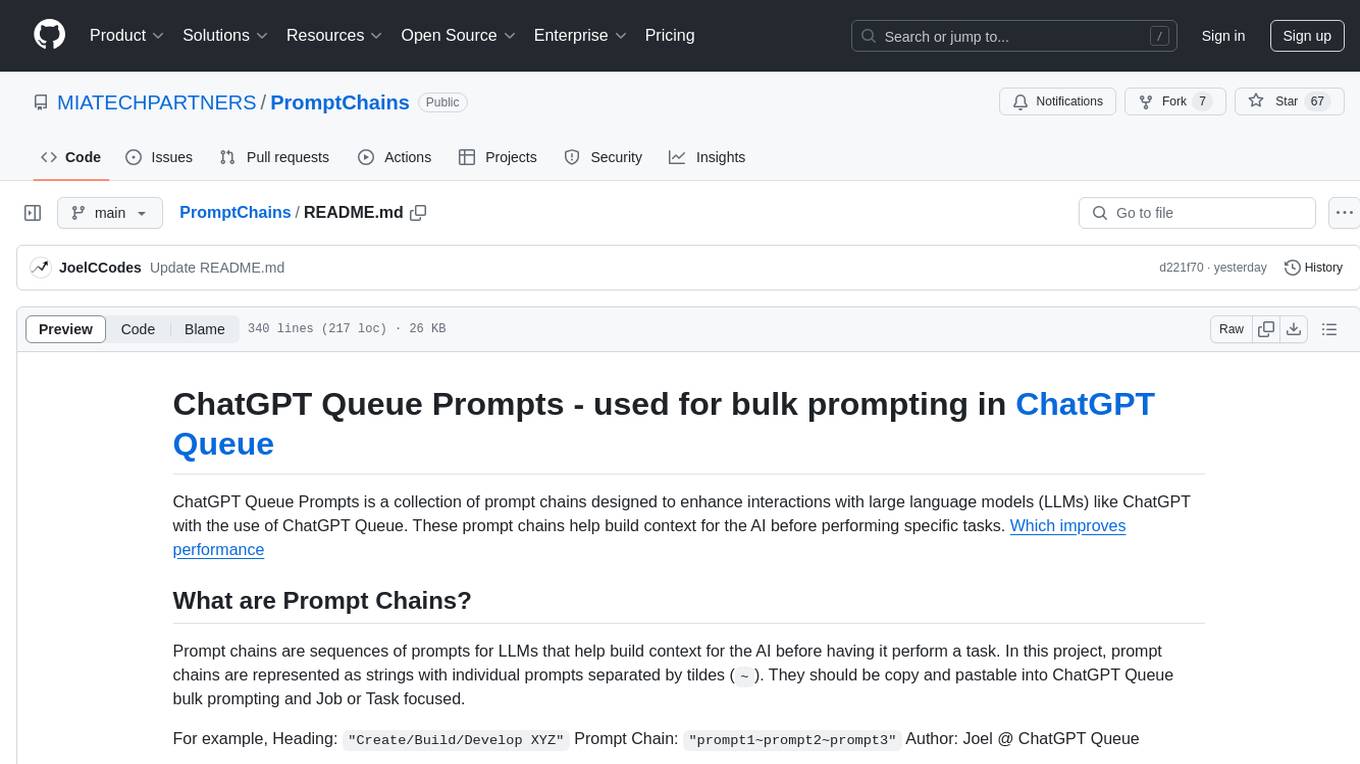
ChatGPT Queue Prompts is a collection of prompt chains designed to enhance interactions with large language models like ChatGPT. These prompt chains help build context for the AI before performing specific tasks, improving performance. Users can copy and paste prompt chains into the ChatGPT Queue extension to process prompts in sequence. The repository includes example prompt chains for tasks like conducting AI company research, building SEO optimized blog posts, creating courses, revising resumes, enriching leads for CRM, personal finance document creation, workout and nutrition plans, marketing plans, and more.
README:
ChatGPT Queue Prompts - used for bulk prompting in ChatGPT Queue
ChatGPT Queue Prompts is a collection of prompt chains designed to enhance interactions with large language models (LLMs) like ChatGPT with the use of ChatGPT Queue. These prompt chains help build context for the AI before performing specific tasks. Which improves performance
Prompt chains are sequences of prompts for LLMs that help build context for the AI before having it perform a task. In this project, prompt chains are represented as strings with individual prompts separated by tildes (~). They should be copy and pastable into ChatGPT Queue bulk prompting and Job or Task focused.
For example,
Heading: "Create/Build/Develop XYZ"
Prompt Chain: "prompt1~prompt2~prompt3"
Author: Joel @ ChatGPT Queue
To use a prompt chain, simply copy the entire chain and paste it into the ChatGPT Queue extension. The AI will process each prompt in sequence, building context before tackling the final task.
This prompt chain helps research publicly traded companies benefiting from the rise of AI:
Using your web search capabilities, I want you to search the web for the latest information on publicly traded companies that are currently benefiting from the rise of AI. Include URL columns where I can learn more about each company, their competitive advantages, and any analyst ratings. Return this back in a table inline. We will research in batches of 10, when I say "More" you find 10 more. Keep the information brief and all within the inline table. Example: | Company Name | Stock Symbol | Competitive Advantages | Analyst Ratings | URL | |--------------|--------------|------------------------------------------|------------------|----------------------------------------| | Company A | ABC | Leading AI technology, strong R&D | Strong Buy | Link | | Company B | XYZ | Dominant in AI software, extensive patents| Moderate Buy | Link | Please provide the latest information available. ~More ~ More ~ More
TOPIC=[white paper topic], INDUSTRY=[target industry], AUDIENCE=[primary reader demographic], LENGTH=[target page count] Use web search to identify 5-7 key challenges or pain points in INDUSTRY related to TOPIC. Summarize each in 1-2 sentences.~Research and list 3-5 current trends or innovations in INDUSTRY that are relevant to TOPIC. Include statistics or data points to support each trend.~Develop a compelling title for the white paper that incorporates TOPIC and appeals to AUDIENCE. Create 3 options and briefly explain the rationale for each.~Craft an executive summary (250-300 words) that outlines the white paper's main points, key findings, and value proposition for AUDIENCE.~Create a detailed outline for the white paper, including: 1. Introduction 2. Background/Context 3. 4-6 main sections addressing key challenges and solutions 4. Case study or real-world example 5. Future outlook 6. Conclusion and recommendations Provide a brief description of the content for each section.~Write the introduction (500-750 words): 1. Hook the reader with a compelling statistic or scenario 2. Provide context for TOPIC in INDUSTRY 3. Clearly state the white paper's purpose and what AUDIENCE will gain 4. Include a brief overview of the main sections~For each main section: 1. Start with a clear subheading 2. Present the challenge or issue 3. Provide in-depth analysis, including data and expert insights 4. Offer potential solutions or best practices 5. Include relevant graphics, charts, or diagrams to illustrate key points Aim for 1000-1500 words per main section.~Develop a case study or real-world example (500-750 words) that illustrates successful implementation of the ideas presented. Include specific outcomes and lessons learned.~Write a future outlook section (500-750 words) that predicts upcoming trends, potential challenges, and opportunities related to TOPIC in INDUSTRY.~Craft a conclusion (500-750 words) that: 1. Summarizes key points 2. Reinforces the importance of addressing TOPIC 3. Provides clear, actionable recommendations for AUDIENCE~Create a visually appealing infographic that summarizes the white paper's main points, key statistics, and recommendations.~Develop a reference list of at least 15 authoritative sources used in the white paper. Ensure proper citation throughout the document.~Write an author bio (100-150 words) that establishes credibility and expertise on TOPIC.~Design a visually appealing cover page and table of contents for the white paper.~Review and edit the entire document for clarity, coherence, and consistency. Ensure it meets LENGTH requirements while maintaining high-quality, substantive content throughout.~Create a one-page summary sheet of the white paper, highlighting key takeaways and enticing AUDIENCE to read the full document.
BRAND=[Brand name], AUDIENCE=[Target audience], DURATION=[Schedule duration in months], PLATFORMS=[List of marketing platforms] Create a comprehensive content schedule for BRAND, targeting AUDIENCE, for a period of DURATION months across PLATFORMS. Begin with an overview of the brand's marketing goals and target audience demographics.~Develop a content strategy outline, including key themes, content types, and frequency of posts for each platform.~Create a monthly breakdown of content themes, aligning with any seasonal trends, industry events, or brand milestones.~Generate a weekly content calendar for the first month, detailing specific post ideas, content types, and optimal posting times for each platform.~Develop a system for categorizing and tagging content (e.g., educational, promotional, user-generated) to ensure a balanced mix.~Outline a process for content creation, including ideation, production, approval, and scheduling workflows.~Suggest a method for tracking content performance and KPIs for each platform.~Propose a strategy for repurposing and cross-promoting content across different platforms.~Create guidelines for maintaining brand voice and visual consistency across all content.~Develop a contingency plan for timely response to trending topics or unforeseen events.~Outline a quarterly review process to assess the content schedule's effectiveness and make data-driven adjustments.~Provide a final summary of the complete content schedule, including key strategies, themes, and expected outcomes.
TOPIC=[subject of the guide], SKILLLEVEL=[beginner/intermediate/advanced], FORMAT=[blog post/video script/infographic]
Research and list the top 5-10 most common questions or pain points people have when learning about or attempting TOPIC.~ Create an outline for the how-to guide, breaking TOPIC down into 5-7 main steps or sections. Ensure the complexity matches SKILLLEVEL.~ Write an engaging introduction that explains why TOPIC is important or beneficial, and what the reader will learn by the end of the guide.~ For each main step or section:
Provide a clear, concise explanation of what needs to be done.
Include any necessary warnings or preparatory steps.
Offer 2-3 tips or best practices related to this step.
If applicable, suggest tools or resources that can help with this step.~ Identify potential challenges or common mistakes related to TOPIC. Create a troubleshooting section addressing these issues with solutions.~ Develop a list of Frequently Asked Questions (FAQs) about TOPIC, complete with clear, concise answers.~ Create a section on "Next Steps" or "Advanced Techniques" for readers who want to go beyond the basics of TOPIC.~ If TOPIC involves any technical terms or jargon, create a glossary defining these terms in simple language.~ Based on FORMAT, suggest appropriate visual aids (e.g., diagrams, screenshots, or video timestamps) to supplement the written content at key points in the guide.~ Write a conclusion that summarizes the key points of the guide and encourages the reader to put their new knowledge into practice.~ Compile all sections into a complete how-to guide formatted appropriately for FORMAT. Include a table of contents if it's a longer piece.
TOPIC=[Topic of presentation], AUDIENCE=[Target audience], DURATION=[Presentation duration in minutes] Create a comprehensive slide deck outline for a presentation on TOPIC, tailored for AUDIENCE, with a duration of DURATION minutes. Include a title slide and a table of contents.~Expand on the table of contents, providing a detailed outline for each section. Include key points, potential visuals, and any data or statistics to be featured.~Write the content for the title slide and introduction slides. Ensure the introduction captures attention and clearly states the presentation's purpose.~Develop the content for the main body slides, focusing on one section at a time. Include clear headings, concise bullet points, and notes for visual elements.~Create transition slides between main sections to maintain flow and coherence throughout the presentation.~Design a strong conclusion that summarizes key points and includes a call to action if appropriate.~Develop any additional slides such as Q&A, references, or contact information.~Review the entire slide deck for consistency, flow, and adherence to best practices in presentation design. Suggest any improvements or additional visual elements that could enhance the presentation.~Provide a final outline of the complete slide deck, including slide numbers and brief descriptions of each slide's content.
TOPIC=[newsletter topic], AUDIENCE=[target audience], FREQUENCY=[daily/weekly/monthly]
Use web search to find the top 5 most recent news stories or developments related to TOPIC. Summarize each in 1-2 sentences.~Based on web search results, identify 3 trending subtopics or themes within TOPIC that are currently generating buzz or controversy.~Use web search to find 3-5 reputable experts or thought leaders in the field of TOPIC. Note their recent contributions or statements.~Create a compelling subject line for the newsletter that incorporates one of the trending subtopics and would appeal to AUDIENCE.~Write an attention-grabbing opening paragraph that introduces the main theme of this issue, relating it to the interests of AUDIENCE.~Develop the main body of the newsletter: 1. Expand on the top news story, providing context and potential impact. 2. Briefly cover 2-3 other significant stories or developments. 3. Include a quote or insight from one of the identified experts. 4. Add a "Did You Know?" section with an interesting fact found through web search.~Use web search to find a relevant statistic or data point related to TOPIC. Create a brief data visualization or infographic concept to illustrate this information.~Based on web search findings, write a "Looking Ahead" section that predicts or speculates on upcoming trends or events in TOPIC.~Create a "Resource Corner" by using web search to find and briefly describe 3 useful resources (articles, tools, websites) related to TOPIC for AUDIENCE.~Develop a call-to-action relevant to TOPIC and AUDIENCE (e.g., attending an event, trying a new technique, participating in a challenge).~Write a brief, engaging conclusion that summarizes the key points and maintains reader interest for the next issue.~Use web search to find appropriate tags or categories for the newsletter content to improve searchability and SEO.~Compile all sections into a cohesive newsletter format. Ensure the tone and complexity are appropriate for AUDIENCE and FREQUENCY.
INDUSTRY=[target industry], TREND=[current trend or technology], PROBLEM=[specific problem to solve]
List 10 emerging trends or technologies in INDUSTRY that could potentially disrupt the market or create new opportunities.~ Identify 5 major pain points or unmet needs in INDUSTRY, focusing specifically on those related to PROBLEM.~ Generate 10 unconventional or "out-of-the-box" product ideas that combine aspects of TREND with solving PROBLEM in INDUSTRY. Don't worry about feasibility at this stage.~ For each of the 10 ideas, briefly describe its core functionality and primary benefit to the user in one sentence.~ Select the 3 most promising ideas from the list. For each, identify 3 potential target user groups and their specific use cases.~ For the top 3 ideas, brainstorm 5 unique features or capabilities that would set each product apart from existing solutions in INDUSTRY.~ Imagine potential obstacles or challenges for each of the top 3 ideas. List 3 major hurdles for each and suggest possible ways to overcome them.~ Combine elements from the top 3 ideas to create 2 hybrid product concepts that might offer more comprehensive solutions to PROBLEM.~ For each of the 2 hybrid concepts, describe a "day in the life" scenario showcasing how the product would be used and its impact on the user.~ Evaluate the 2 hybrid concepts and the original top 3 ideas based on innovation, market potential, and alignment with TREND. Rank them from most to least promising.~ For the highest-ranked idea, outline a basic product roadmap including 3 development phases and key milestones for bringing it to market.
TICKER=[Stock ticker symbol], COMPANY=[Company name], Provide a brief overview of COMPANY (TICKER), including its primary business model, key products or services, and position within the SECTOR industry.~Analyze COMPANY's financial statements for the past 5 years. Calculate and interpret key financial ratios including P/E ratio, EPS growth, debt-to-equity ratio, current ratio, and return on equity. Identify any notable trends or red flags.~Examine COMPANY's revenue streams and profit margins. Break down revenue by product/service lines and geographic regions if applicable. Analyze the stability and growth potential of each revenue source.~Evaluate COMPANY's competitive position within SECTOR. Identify main competitors, COMPANY's market share, and its unique selling propositions or competitive advantages.~Analyze COMPANY's management team. Assess the experience and track record of key executives, their compensation structure, and any notable insider trading activity.~Investigate COMPANY's growth strategy. Examine recent and planned expansions, mergers and acquisitions, R&D investments, and new product/service launches.~Assess COMPANY's risks and challenges. Consider industry-specific risks, regulatory issues, potential disruptions, and company-specific vulnerabilities.~Analyze COMPANY's stock performance over the past 5 years. Compare it to relevant market indices and key competitors. Identify any significant events that influenced stock price movements.~Examine analyst opinions and price targets for TICKER. Summarize the bull and bear cases for the stock.~Investigate COMPANY's corporate governance practices. Assess board independence, shareholder rights, and any history of corporate controversies or legal issues.~Analyze COMPANY's dividend history and policy, if applicable. Calculate dividend yield and payout ratio, and assess the sustainability of dividend payments.~Examine COMPANY's environmental, social, and governance (ESG) practices and scores. Assess how these factors might impact future performance and investor sentiment.~Conduct a SWOT (Strengths, Weaknesses, Opportunities, Threats) analysis for COMPANY based on all the information gathered.~Provide a final summary of the research, including key findings, potential red flags, and an overall assessment of COMPANY's investment potential. Include a suggested valuation range for TICKER based on the analysis.
Research and provide a list of 5 high-volume, low-competition keywords related to selling digital products. Include search volume and keyword difficulty for each~Based on the keyword research, generate a compelling blog post title that incorporates the primary keyword~Create an outline for the blog post with the following sections: Introduction, [3-5 main content sections based on secondary keywords], Conclusion~Write a meta description for the blog post, incorporating the primary keyword and staying within 150-160 characters~Write the Introduction section, including the primary keyword in the first paragraph and a clear thesis statement~Write Section 1 of the main content, incorporating relevant secondary keywords naturally~Write Section 2 of the main content, including relevant statistics or data to support your points~Write Section 3 of the main content, addressing common questions or concerns related to the topic~[If applicable] Write Sections 4 and 5 of the main content, providing additional value and incorporating remaining secondary keywords~Write the Conclusion section, summarizing key points and including a call-to-action~Create a list of 5-7 internal and external link suggestions to be incorporated throughout the post~Generate 3 options for engaging meta titles, each under 60 characters and including the primary keyword~Provide a list of image suggestions for the post, including recommended alt text for each image~Create a list of 3-5 related blog post ideas to be used for internal linking
BUSINESS=[business name], INDUSTRY=[industry], PRODUCT=[main product/service], TIMEFRAME=[5-year projection]
Write an executive summary (250-300 words) outlining BUSINESS's mission, PRODUCT, target market, unique value proposition, and high-level financial projections.~Provide a detailed description of PRODUCT, including its features, benefits, and how it solves customer problems. Explain its unique selling points and competitive advantages in INDUSTRY.~Conduct a market analysis: 1. Define the target market and customer segments 2. Analyze INDUSTRY trends and growth potential 3. Identify main competitors and their market share 4. Describe BUSINESS's position in the market~Outline the marketing and sales strategy: 1. Describe pricing strategy and sales tactics 2. Explain distribution channels and partnerships 3. Detail marketing channels and customer acquisition methods 4. Set measurable marketing goals for TIMEFRAME~Develop an operations plan: 1. Describe the production process or service delivery 2. Outline required facilities, equipment, and technologies 3. Explain quality control measures 4. Identify key suppliers or partners~Create an organization structure: 1. Describe the management team and their roles 2. Outline staffing needs and hiring plans 3. Identify any advisory board members or mentors 4. Explain company culture and values~Develop financial projections for TIMEFRAME: 1. Create a startup costs breakdown 2. Project monthly cash flow for the first year 3. Forecast annual income statements and balance sheets 4. Calculate break-even point and ROI~Conclude with a funding request (if applicable) and implementation timeline. Summarize key milestones and goals for TIMEFRAME.
TOPIC=[article topic], KEYWORD=[primary keyword], WORDCOUNT=[target word count, minimum 2000], AUDIENCE=[target reader persona]
Use web search to identify the top 10 ranking pages for KEYWORD. Analyze their content structure, headings, and key points covered.~
Based on the analysis, create a detailed outline with at least 15 headings and subheadings (H1, H2, H3, H4) that comprehensively cover TOPIC. Ensure the outline has a logical flow and addresses key user intents.~
Research and list 10-15 related long-tail keywords and LSI (Latent Semantic Indexing) terms relevant to TOPIC. Plan to naturally incorporate these throughout the article.~
Craft an engaging, SEO-optimized title (H1) that includes KEYWORD and appeals to AUDIENCE. Ensure it's under 60 characters for optimal display in search results.~
Write a compelling introduction (150-200 words) that hooks the reader, introduces TOPIC, and outlines what the article will cover. Naturally include KEYWORD.~
For each main section (H2) in the outline:
1. Write 300-500 words of in-depth, informative content.
2. Include relevant examples, data, or case studies found through web search.
3. Naturally incorporate 1-2 related long-tail keywords or LSI terms.
4. Ensure a conversational tone that speaks directly to AUDIENCE.
5. Add a unique insight or perspective not commonly found in competing articles.~
Create 2-3 custom images, diagrams, or infographic concepts that visually explain key points in the article. Describe each in detail, including alt text optimized for KEYWORD.~
Write a "Quick Takeaways" or "Key Points" section that summarizes the main insights of the article in 5-7 bullet points.~
Develop a conclusion (200-250 words) that summarizes the key points, reinforces the main message, and includes a call-to-action relevant to AUDIENCE.~
Create 5 unique, relevant FAQs related to TOPIC. Ensure answers are concise yet informative, and naturally include long-tail keywords.~
Write a custom message asking for reader feedback and encouraging social shares. Include a question to boost engagement.~
Use web search to identify 3-5 authoritative external sources relevant to TOPIC. Create in-text citations and a "References" section at the end of the article.~
Review the entire article to ensure optimal keyword density (aim for 1-2% for KEYWORD), proper use of headings, and inclusion of long-tail keywords. Check that the content maintains high perplexity and burstiness while staying on topic.~
Format the article using Markdown, ensuring all headings (H1, H2, H3, H4) and important points are properly styled. Bold key phrases and use italics for emphasis where appropriate.~
Compile the full article, including the title, introduction, main body with all sections, images, conclusion, FAQs, engagement message, and references. Ensure it meets or exceeds WORDCOUNT while maintaining high-quality, engaging content throughout.
Define the course parameters: SUBJECT=[subject name], AUDIENCE=[target audience], DURATION=[course length in weeks]~Create a course outline with main modules, each focusing on a key aspect of the subject~For each module, list 3-5 specific learning objectives that align with the overall course goals~Develop a detailed syllabus including module titles, topics covered, estimated time for completion, and required materials~Create an introduction module that explains the course structure, expectations, and provides an overview of the subject~For Module 1, design a lesson plan with lecture content, practical exercises, and multimedia resources~Develop assessment methods for Module 1, including quizzes, assignments, or projects that test the module's learning objectives~Repeat the lesson plan and assessment development process for the next half of the modules~Create interactive elements for each module, such as discussion prompts, group activities, or hands-on projects~Design a mid-course project or assignment that integrates concepts from the first half of the course~Develop lesson plans and assessments for the remaining modules, incorporating more advanced concepts and building on earlier modules~Create a final project or exam that comprehensively assesses the entire course content~Develop a resource list including textbooks, online materials, and supplementary reading for each module~Create a glossary of key terms and concepts covered throughout the course~Design a feedback mechanism for students to evaluate the course and suggest improvements~Develop a guide for instructors, including teaching tips, common student challenges, and suggested solutions~Create a course completion certificate template and criteria for earning the certificate
Analyze the following resume details: INDUSTRY=[target industry], EXPERIENCE_LEVEL=[entry/mid/senior], JOB_TITLE=[desired position]~Review the current RESUME=[] and identify 5 key strengths and 3 areas for improvement~Optimize the resume summary/objective statement to align with the target job and industry (max 3 sentences)~Revise the work experience section: enhance 3 key accomplishments for each role using the STAR method and quantifiable results~Identify and list 5-7 relevant hard skills and 3-5 soft skills that align with the target job requirements~Restructure the skills section to highlight the most impactful and relevant skills~Review and optimize the education section, including relevant coursework, projects, or academic achievements~Create a tailored section highlighting 3-4 key projects or notable achievements relevant to the target job~Identify and incorporate 5-7 industry-specific keywords or phrases throughout the resume~Revise the resume format for improved readability: suggest appropriate fonts, spacing, and section organization~Proofread the entire resume and correct any grammatical or formatting inconsistencies~Generate 3 impactful action verbs to replace weak or overused verbs in the experience section~Create a concise list of 3-5 relevant certifications or professional development activities to add, if applicable~Suggest 2-3 optional sections that could enhance the resume (e.g., volunteer work, publications, languages)~Develop a strategy to address any potential red flags (e.g., employment gaps, career changes) in the resume~Provide a final checklist of 5 key elements to review before submitting the revised resume
Lead Enrichment Task
Welcome to the lead enrichment task! Your goal is to enrich a list of email addresses by gathering detailed and relevant information for each one. This process is essential for building a comprehensive understanding of each lead, which can significantly enhance engagement and targeting strategies. Here’s a step-by-step guide on how to proceed:
Step-by-Step Instructions:
List of Emails:
I will provide you with a comprehensive list of email addresses. This list is your starting point and contains the leads that require enrichment.
Sequential Processing:
Begin with the first email address on the list. When I say "next," you will move on to the subsequent email address. This method ensures a structured and organized approach, allowing for systematic data collection.
Information Gathering:
For each email address, your task is to search for and compile the following pieces of relevant information. This data will help paint a complete picture of each lead:
Name: Identify the person or organization associated with the email. This can often be found through professional networks or company directories.
Job Title or Position: Determine the current job title or role of the individual. LinkedIn is a valuable resource for this information.
Social Media Profiles: Locate profiles on platforms like LinkedIn, Twitter, or Facebook. These profiles can provide insights into professional interests and activities.
Company Information: Gather details about the company they are associated with, such as industry, size, and key personnel.
Publicly Available Contact Information: This might include phone numbers, secondary email addresses, or office addresses. Ensure this data is publicly accessible to comply with privacy regulations.
Recent News or Articles: Look for any recent news, articles, or press releases involving the person or their organization. This context can be valuable for understanding their current focus and achievements.
Data Sources:
Reputable Sources: Prioritize information from reputable and authoritative sources to ensure accuracy. LinkedIn, official company websites, Google, and professional networks are excellent starting points.
Search Engines: Utilize search engines effectively by using specific and targeted queries that can help pinpoint the necessary information.
Compliance:
Legal and Privacy Regulations: Ensure that all information gathering complies with relevant legal and privacy regulations, such as GDPR and CCPA. Avoid using methods that could infringe on privacy rights or involve unauthorized data scraping.
Handling Ambiguity:
Multiple Matches: If multiple matches are found for an email address, use context clues such as company affiliation or job title to select the most relevant result.
No Information Found: If no relevant information is found after a thorough search, log this as an unsuccessful search and proceed to the next email. Documenting this helps maintain a record of search attempts and outcomes.
Output Format:
Structured Presentation: Present the gathered information in a structured format such as a table or a JSON file. This format should include clearly labeled fields for each piece of data, making it easy to review and utilize.
Error Handling:
Unsuccessful Searches: Log any instances where the search was unsuccessful or incomplete. This log can help in reviewing the search process and identifying potential improvements.
Rate Limiting and Ethical Considerations:
Avoid Excessive Querying: Be mindful of the terms of service for data providers. Excessive querying can lead to restrictions or bans, so it’s essential to respect these limits.
Ethical Guidelines: Adhere to ethical guidelines in data gathering, ensuring that all information collected is done so responsibly and respectfully.
Let’s begin this enriching journey. Start by examining the first email address, and when you’re ready to move on, simply say "next." Your thorough and diligent approach will greatly enhance the value of these leads, providing a rich foundation for further engagement and strategic actions.
[Email List]
~next~next~next~next~next~next~next~next~next~next~next~next~next~next~
Create a monthly budget template with categories for income, fixed expenses, variable expenses, and savings. Include formulas for calculating totals and percentages~Develop a yearly financial goals worksheet with sections for short-term, medium-term, and long-term goals. Include columns for goal description, target amount, deadline, and action steps~Generate a net worth statement template with sections for assets (e.g., cash, investments, property) and liabilities (e.g., loans, credit card debt). Include formulas for calculating total net worth~Design a debt repayment plan spreadsheet with columns for creditor name, balance, interest rate, minimum payment, and projected payoff date. Include a debt snowball/avalanche calculation~Create an emergency fund planning document that calculates target fund size based on monthly expenses and provides a savings timeline~Develop an investment portfolio allocation spreadsheet with sections for different asset classes (e.g., stocks, bonds, real estate) and risk tolerance levels~Generate a retirement savings calculator that estimates required savings based on current age, desired retirement age, and expected expenses~Create a cash flow statement template with sections for operating activities, investing activities, and financing activities~Design a tax preparation checklist customized for individual tax situations, including needed documents and common deductions~Develop a personal financial ratios worksheet calculating key metrics like savings rate, debt-to-income ratio, and investment returns~Create an insurance coverage summary template listing all policies, coverage amounts, premiums, and renewal dates~Generate a bill payment tracker with recurring expenses, due dates, and payment confirmation fields~Design a charitable giving plan template with sections for donation goals, tax implications, and impact tracking~Create a financial document organization guide with categories for storing and managing important financial papers~Develop a personal finance dashboard template summarizing key financial metrics, goals progress, and action items
Analyze the following information: Current body weight [weight in kg/lbs], Height [height in cm/inches], Age [age in years], Gender [male/female/other], and Fitness goal [e.g., weight loss, muscle gain, general fitness]~Calculate the individual's BMI and determine their ideal weight range based on height~Estimate the individual's daily caloric needs based on their stats and activity level~Create a macronutrient breakdown (protein, carbs, fats) tailored to their fitness goal~Develop a 7-day meal plan with specific meals and portion sizes that meet the calculated macronutrient needs~Generate a grocery list based on the meal plan, categorized by food groups~Design a 4-week workout plan with 4-5 sessions per week, tailored to the individual's fitness goal~For Week 1, provide detailed descriptions of each workout, including exercises, sets, reps, and rest periods~For Weeks 2-4, outline any progressions or changes in the workout routine to ensure continued progress~Suggest 3-5 supplement recommendations, if appropriate, based on the individual's goal~Create a list of 5-7 tips for staying motivated and adhering to the workout and nutrition plan~Develop a progress tracking system, including metrics to monitor and frequency of measurements~Generate a sample workout log template for the individual to record their exercises and progress~Provide guidelines for adjusting the plan based on progress or plateaus after the 4-week period
Based on the Diffusion of innovations theory, I want you to help me build a marketing plan for each step for marketing my product, My product [Its called ChatGPT Queue it saves people time by allowing them to queue messages for ChatGPT, I have a one time fee, its a chrome extension]. Start by generating the Table of contents for my marketing plan with only the following sections
Here are what the only 5 sections of the outline should look like,
Innovators
Early Adopters
Early Majority
Late Majority
Laggards
Use your search capabilities to enrich each section of the marketing plan.
~
Write Section 1
~
Write Section 2
~
Write Section 3
~
Write Section 4
~
Write Section 5
Analyze the following prompt idea: [insert prompt idea]~Rewrite the prompt for clarity and effectiveness~Identify potential improvements or additions~Refine the prompt based on identified improvements~Present the final optimized prompt
Analyze the following YouTube video transcript: [insert transcript]~Identify key points and main ideas~Create a concise summary of the video content~List the most important takeaways in bullet points~Suggest related topics for further exploration
Create a table of contents for a business plan for [type of business]~Write the executive summary~Develop the company description and market analysis~Detail the product or service offering~Outline the marketing and sales strategy~Generate financial projections~Formulate the funding request~Compile all sections into a complete business plan
Use the following parameters to create a children's story: Characters: [list characters], Lesson: [specify lesson], Age range: [specify age range], Word count: [specify word count]~Create a story outline~Write the full story~Revise for age-appropriateness and word count~Suggest potential illustrations or interactive elements
Analyze the following code snippet: [insert code]~Explain the code functionality line by line~Identify bugs and inefficiencies~Suggest optimizations for performance and readability~Provide an optimized version with explanatory comments
Generate a 7-day meal plan for the following dietary preferences: [list preferences]~Create a comprehensive shopping list~Calculate estimated total cost~Provide meal prep instructions~Suggest time-saving cooking tips
Create a 30-day study plan for learning [target language] at a [beginner/intermediate/advanced] level~Compile a list of essential phrases and translations~Recommend learning resources (apps, podcasts, videos)~Develop practice exercises and quizzes
Analyze the following technical problem: [describe problem]~Identify potential causes~Suggest step-by-step troubleshooting methods~Provide a clear solution in simple terms~Recommend preventive measures for future issues
Analyze the book "[Title]" by [Author]~Summarize the book's plot or main arguments~Identify key themes and concepts~Analyze character development or main ideas~Discuss the author's writing style and tone~Explore historical or cultural context~Suggest similar books or further reading
Create a personal finance plan using the following information: Monthly income: [amount], Major expenses: [list expenses], Financial goals: [list goals]~Develop a detailed monthly budget~Provide investment recommendations based on a [low/medium/high] risk tolerance~Suggest methods to increase income~Create a debt repayment strategy if applicable
Identify the key strengths of [company/product]~List potential weaknesses or areas for improvement~Explore market opportunities for growth~Analyze potential threats or challenges~Summarize findings and suggest strategic actions
Define target audience and market segmentation for [product/service]~Set specific, measurable marketing objectives~Outline marketing strategies and tactics~Create a marketing budget~Develop a timeline for implementation~Establish KPIs for measuring success
Identify top 5 competitors in [industry/niche]~Analyze their products/services and pricing strategies~Evaluate their marketing and branding approaches~Assess their strengths and weaknesses~Identify potential opportunities for differentiation~Summarize findings and strategic recommendations
Define sales objectives for [product/service]~Identify target customer segments~Outline the sales process and cycle~Develop sales tactics and techniques~Create a sales forecast~Suggest tools and resources for sales team
Summarize the business opportunity for [project/idea]~Provide a detailed solution or approach~Outline the benefits and value proposition~Present a pricing structure or cost analysis~Include a project timeline and milestones~Close with a compelling call to action
Identify key skills and knowledge areas for [job role/department]~Develop learning objectives and outcomes~Create an outline of training modules and content~Suggest delivery methods (e.g., workshops, e-learning)~Design assessment and feedback mechanisms~Propose a schedule and resources needed
Analyze current customer churn rate and reasons~Identify key factors influencing customer loyalty~Develop strategies to improve customer satisfaction~Create a loyalty program outline~Design a communication plan for customer engagement~Suggest metrics to measure retention efforts
Project revenue for the next 12 months for [business/product line]~Estimate costs and expenses~Calculate projected profit margins~Develop cash flow projections~Identify potential financial risks~Suggest strategies for financial growth and stability
Outline the unique value proposition of [new product]~Develop a pre-launch marketing strategy~Create a timeline for the launch process~Design a pricing strategy~Plan the actual launch event or campaign~Develop a post-launch evaluation process
Map the current supply chain for [product/service]~Identify inefficiencies and bottlenecks~Suggest improvements for cost reduction~Recommend strategies for better inventory management~Propose methods to enhance supplier relationships~Outline implementation steps for supply chain optimization
Identify potential crisis scenarios for [company/industry]~Create a crisis management team structure~Develop key messaging templates~Outline communication channels and protocols~Create a step-by-step response process~Design a post-crisis evaluation and recovery plan
Assess current environmental impact of [company/industry]~Set sustainability goals and objectives~Develop strategies for reducing carbon footprint~Create initiatives for waste reduction and resource conservation~Design an employee engagement plan for sustainability~Outline reporting and communication strategies for sustainability efforts
Assess current digital capabilities of [company]~Identify areas for digital innovation and improvement~Outline required technological investments~Develop a plan for data management and analytics~Create a timeline for implementation~Design change management strategies for digital adoption
Identify key intellectual property assets of [company]~Outline processes for protecting new innovations~Develop strategies for patent filing and management~Create guidelines for trade secret protection~Design a plan for trademark and copyright management~Suggest methods for IP valuation and commercialization
Assess current employee satisfaction levels~Identify key drivers of employee engagement~Design recognition and reward systems~Develop strategies for improving work-life balance~Create a plan for enhancing internal communication~Outline metrics for measuring engagement success
Define the main topic and learning objectives for [course subject]~Identify the target audience and their prior knowledge level~Create a course outline with main modules and sub-topics~Develop a detailed syllabus including lesson plans and time allocation~Design engaging learning activities and assignments for each module~Create assessment methods to evaluate student progress and understanding~Outline required resources (textbooks, software, equipment) for the course~Develop a strategy for delivering the course (in-person, online, or hybrid)~Create a marketing plan to promote the course to potential students~Design a feedback mechanism for continuous course improvement
Analyze the following SaaS product and create a brief: ChatGPT Queue. Include key features, benefits, target audience, and industry~Based on the brief, list 5 key concepts or themes that should be represented in the logo~Generate a minimalist logo design for the SaaS product. Use only two colors and focus on a simple, memorable shape~Create a bold and modern logo design using gradients and a sans-serif font. Incorporate an abstract representation of the product's main feature~Design a playful logo with a mascot or character that represents the product's personality. Use a vibrant color palette~Develop a tech-focused logo design with a futuristic feel. Incorporate circuit-like patterns or digital elements~Create an elegant and professional logo design using a monogram or lettermark. Stick to a monochromatic color scheme~Generate a versatile logo that works well in both horizontal and vertical layouts. Focus on scalability and readability at different sizes
To contribute your own prompt chains, please follow these steps:
- Fork the repository
- Create a new branch (
git checkout -b feature/new-prompt-chain) - Add your prompt chain to the appropriate section
- Commit your changes (
git commit -am 'Add new prompt chain') - Push to the branch (
git push origin feature/new-prompt-chain) - Create a new Pull Request
For support, feature requests, or any questions, please visit our Chrome Web Store page:
If you find ChatGPTQueuePrompts helpful, please consider leaving a review on our Chrome Web Store page. Your feedback helps us improve and reach more users!
Feel free to star ⭐ this repository if you find it helpful!
For Tasks:
Click tags to check more tools for each tasksFor Jobs:
Alternative AI tools for PromptChains
Similar Open Source Tools

PromptChains
ChatGPT Queue Prompts is a collection of prompt chains designed to enhance interactions with large language models like ChatGPT. These prompt chains help build context for the AI before performing specific tasks, improving performance. Users can copy and paste prompt chains into the ChatGPT Queue extension to process prompts in sequence. The repository includes example prompt chains for tasks like conducting AI company research, building SEO optimized blog posts, creating courses, revising resumes, enriching leads for CRM, personal finance document creation, workout and nutrition plans, marketing plans, and more.
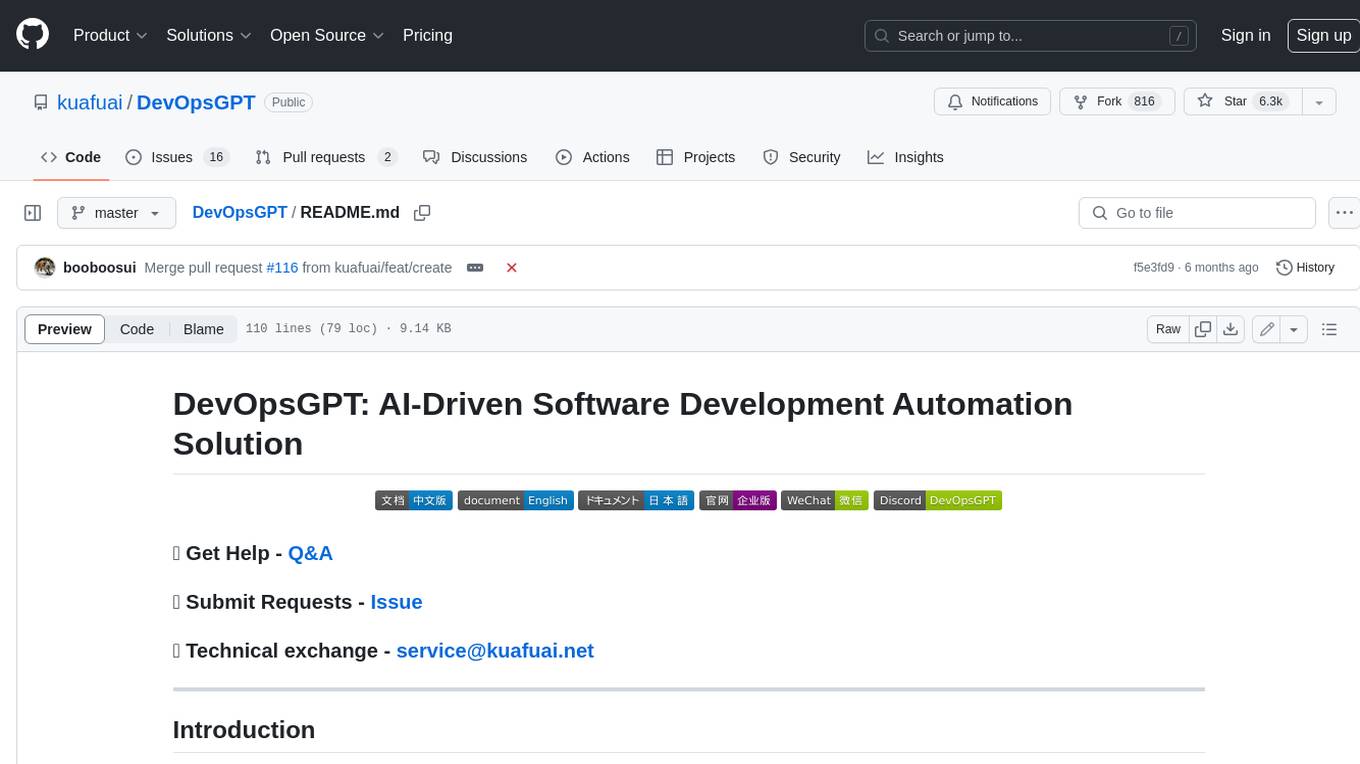
DevOpsGPT
DevOpsGPT is an AI-driven software development automation solution that combines Large Language Models (LLM) with DevOps tools to convert natural language requirements into working software. It improves development efficiency by eliminating the need for tedious requirement documentation, shortens development cycles, reduces communication costs, and ensures high-quality deliverables. The Enterprise Edition offers features like existing project analysis, professional model selection, and support for more DevOps platforms. The tool automates requirement development, generates interface documentation, provides pseudocode based on existing projects, facilitates code refinement, enables continuous integration, and supports software version release. Users can run DevOpsGPT with source code or Docker, and the tool comes with limitations in precise documentation generation and understanding existing project code. The product roadmap includes accurate requirement decomposition, rapid import of development requirements, and integration of more software engineering and professional tools for efficient software development tasks under AI planning and execution.
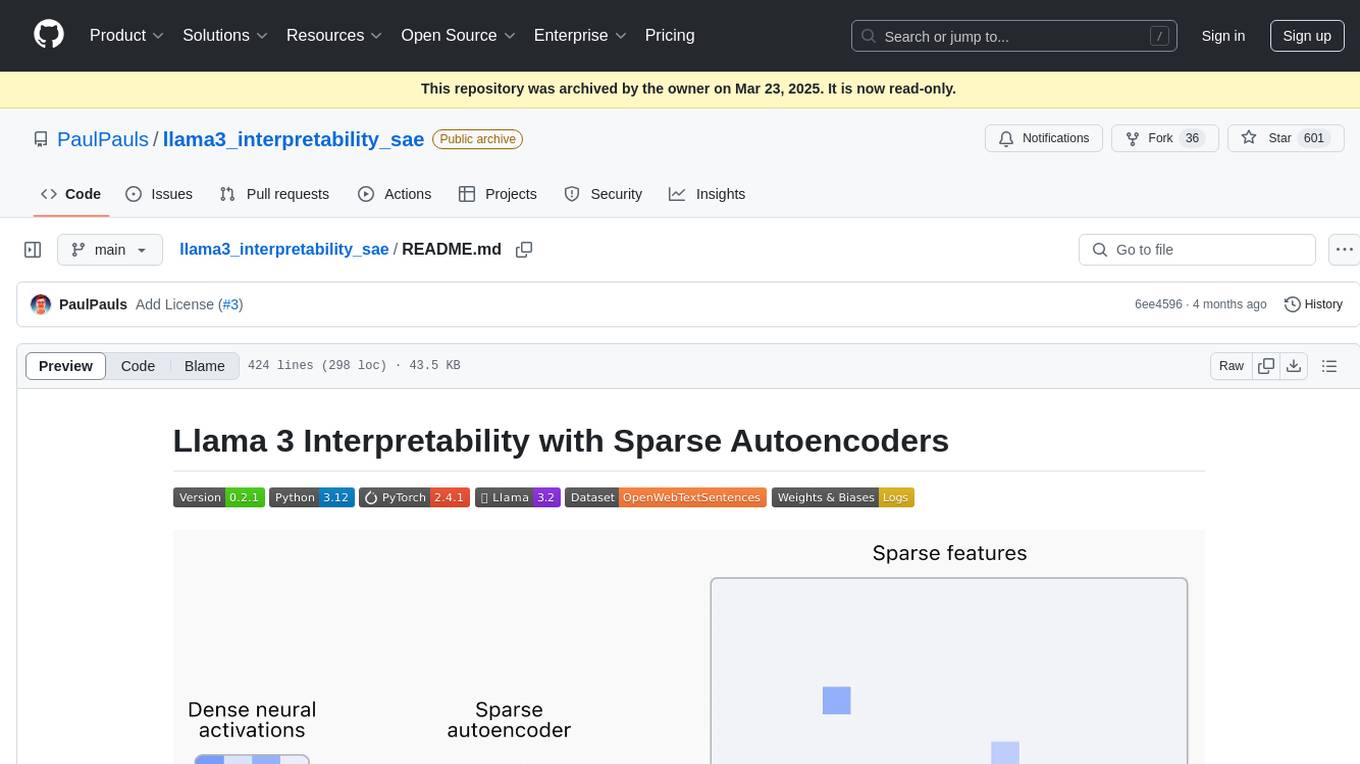
llama3_interpretability_sae
This project focuses on implementing Sparse Autoencoders (SAEs) for mechanistic interpretability in Large Language Models (LLMs) like Llama 3.2-3B. The SAEs aim to untangle superimposed representations in LLMs into separate, interpretable features for each neuron activation. The project provides an end-to-end pipeline for capturing training data, training the SAEs, analyzing learned features, and verifying results experimentally. It includes comprehensive logging, visualization, and checkpointing of SAE training, interpretability analysis tools, and a pure PyTorch implementation of Llama 3.1/3.2 chat and text completion. The project is designed for scalability, efficiency, and maintainability.
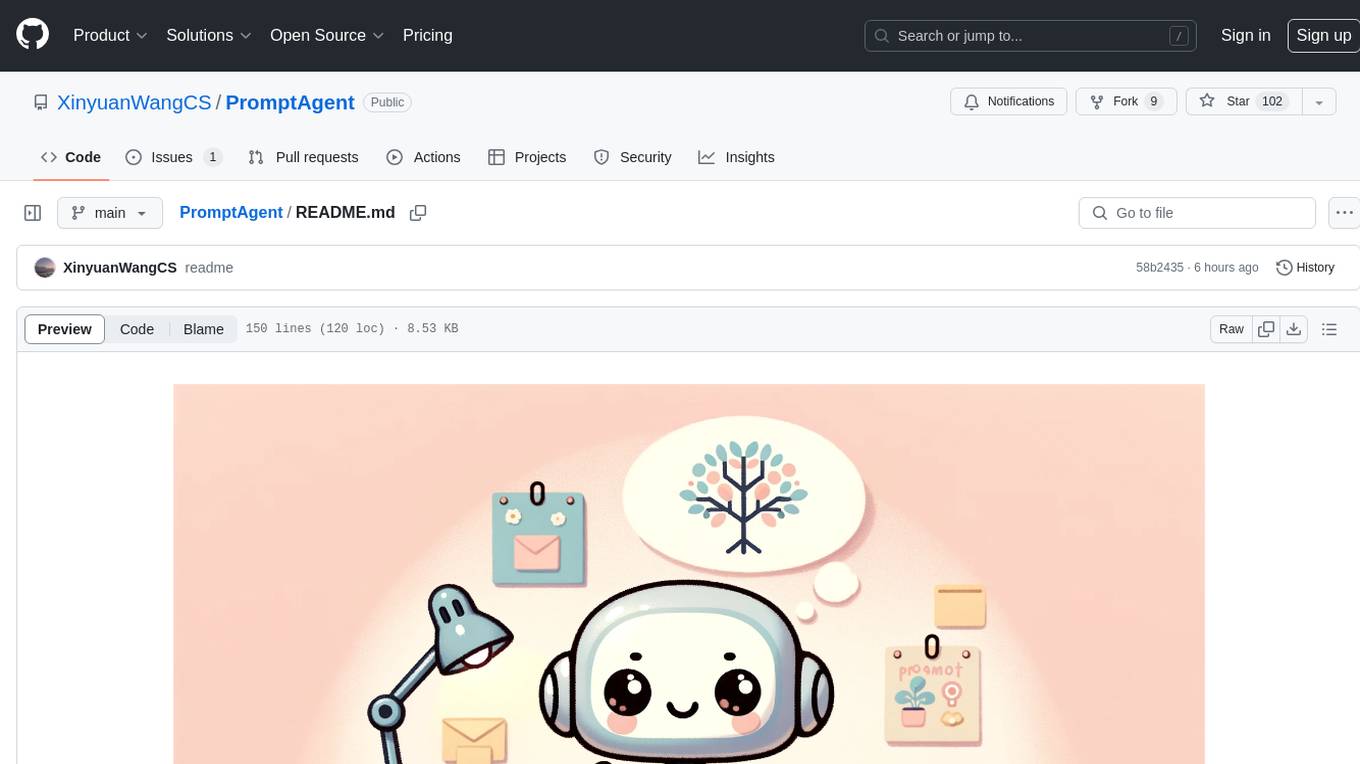
PromptAgent
PromptAgent is a repository for a novel automatic prompt optimization method that crafts expert-level prompts using language models. It provides a principled framework for prompt optimization by unifying prompt sampling and rewarding using MCTS algorithm. The tool supports different models like openai, palm, and huggingface models. Users can run PromptAgent to optimize prompts for specific tasks by strategically sampling model errors, generating error feedbacks, simulating future rewards, and searching for high-reward paths leading to expert prompts.

Me-LLaMA
Me LLaMA introduces a suite of open-source medical Large Language Models (LLMs), including Me LLaMA 13B/70B and their chat-enhanced versions. Developed through innovative continual pre-training and instruction tuning, these models leverage a vast medical corpus comprising PubMed papers, medical guidelines, and general domain data. Me LLaMA sets new benchmarks on medical reasoning tasks, making it a significant asset for medical NLP applications and research. The models are intended for computational linguistics and medical research, not for clinical decision-making without validation and regulatory approval.
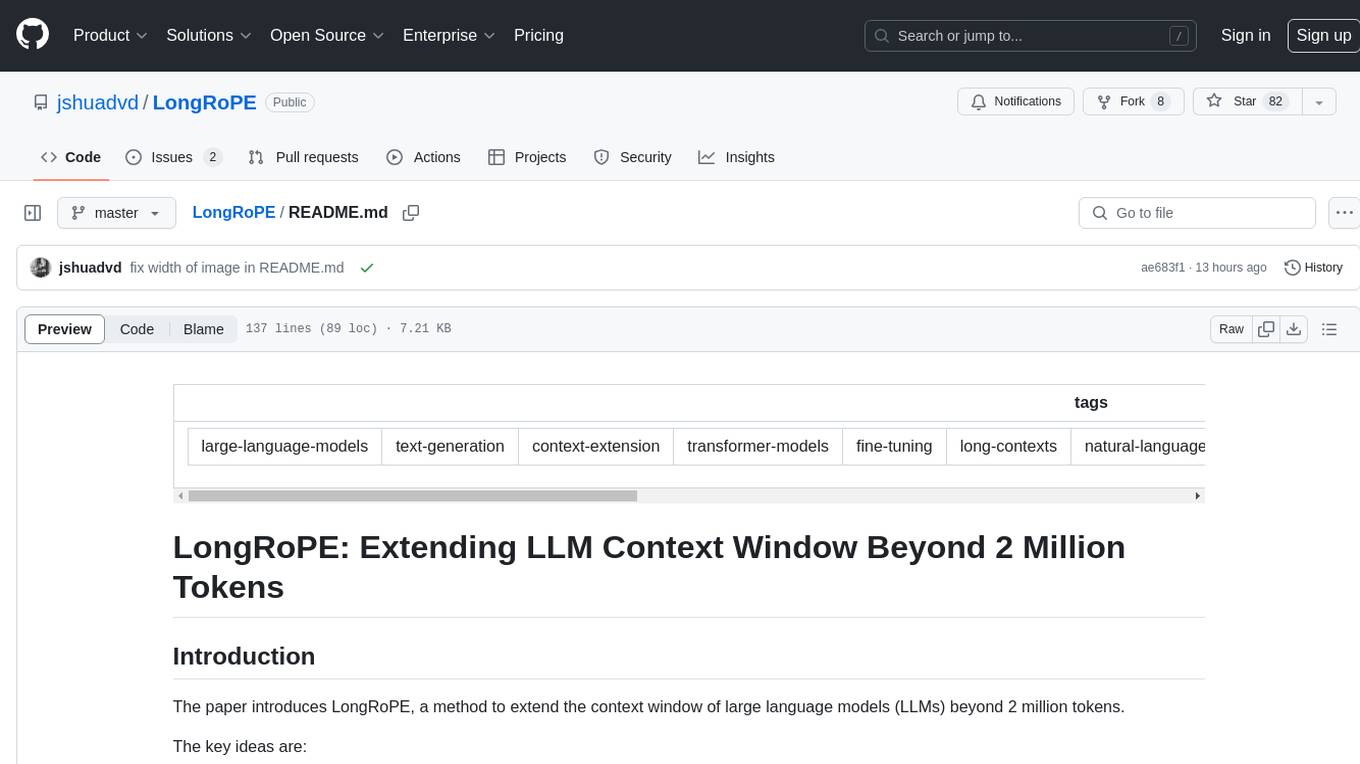
LongRoPE
LongRoPE is a method to extend the context window of large language models (LLMs) beyond 2 million tokens. It identifies and exploits non-uniformities in positional embeddings to enable 8x context extension without fine-tuning. The method utilizes a progressive extension strategy with 256k fine-tuning to reach a 2048k context. It adjusts embeddings for shorter contexts to maintain performance within the original window size. LongRoPE has been shown to be effective in maintaining performance across various tasks from 4k to 2048k context lengths.
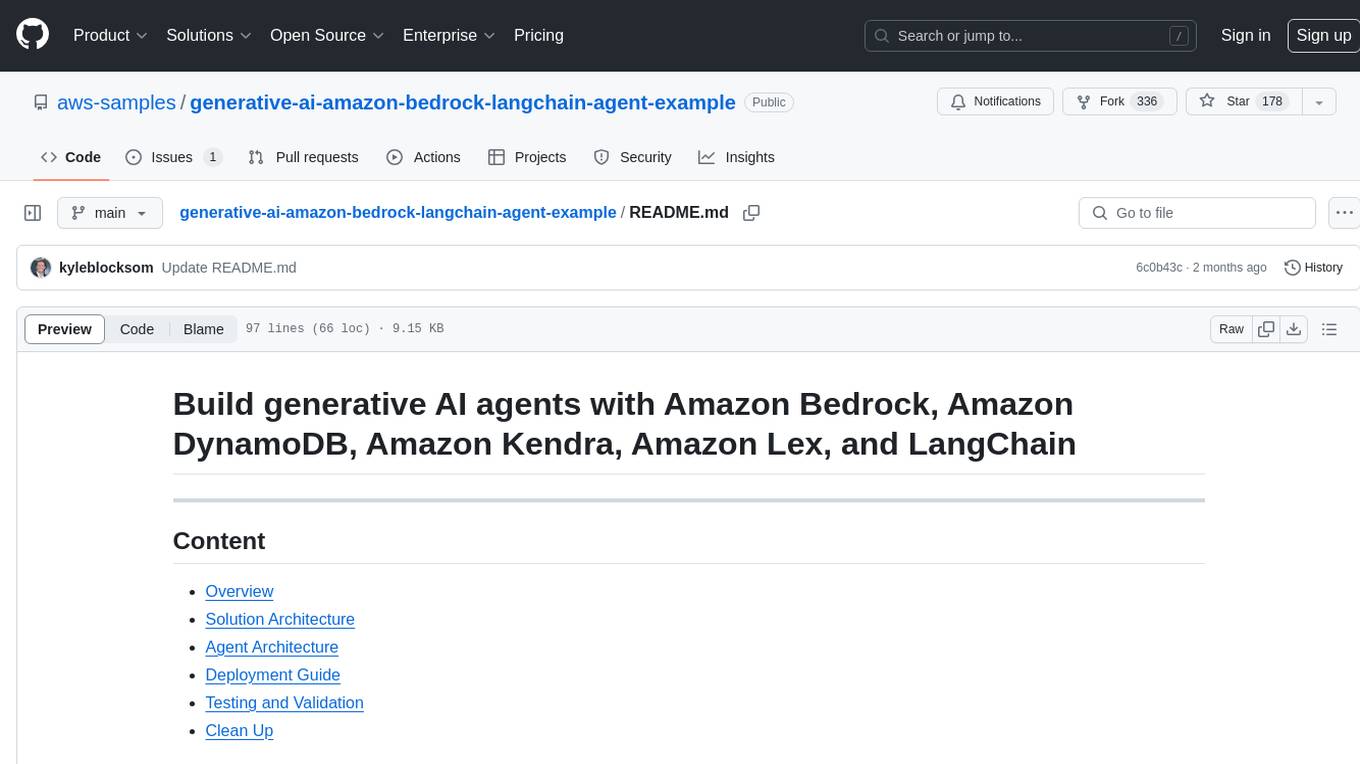
generative-ai-amazon-bedrock-langchain-agent-example
This repository provides a sample solution for building generative AI agents using Amazon Bedrock, Amazon DynamoDB, Amazon Kendra, Amazon Lex, and LangChain. The solution creates a generative AI financial services agent capable of assisting users with account information, loan applications, and answering natural language questions. It serves as a launchpad for developers to create personalized conversational agents for applications like chatbots and virtual assistants.
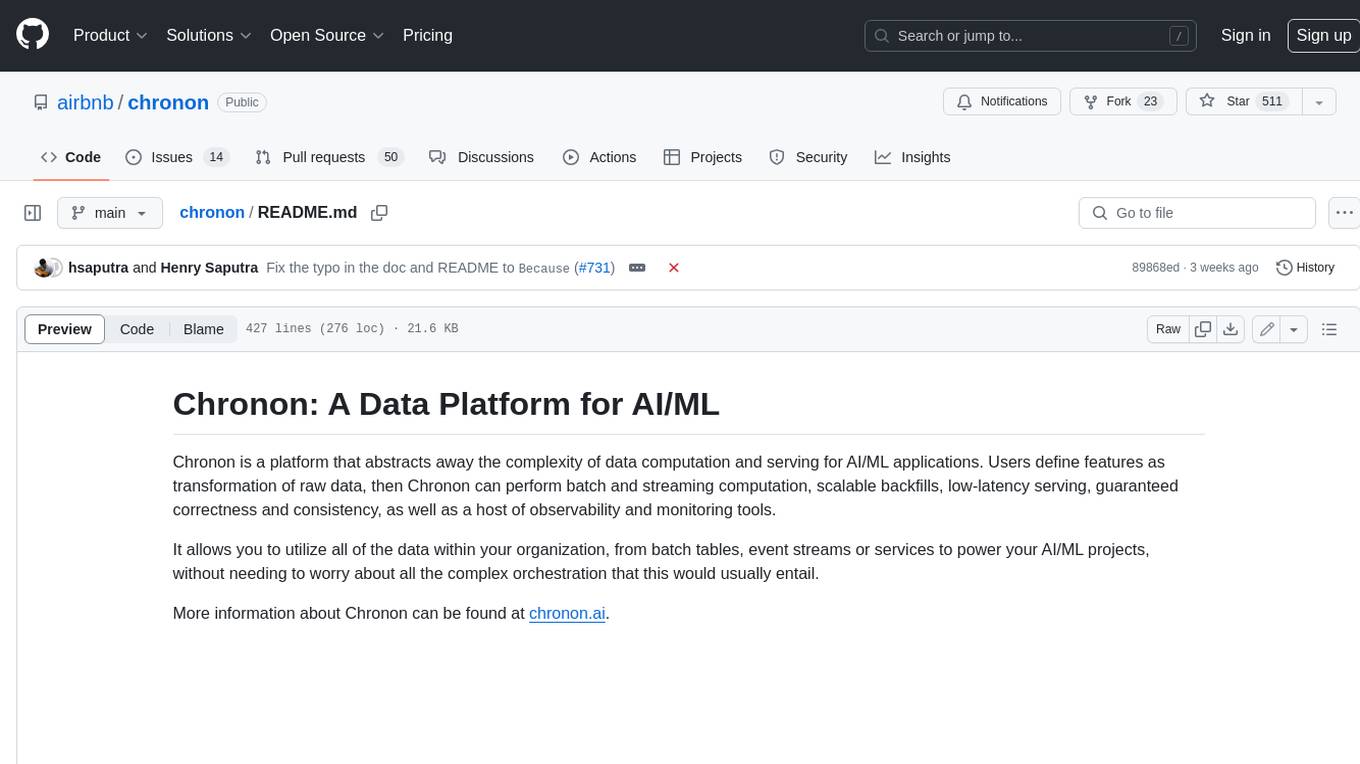
chronon
Chronon is a platform that simplifies and improves ML workflows by providing a central place to define features, ensuring point-in-time correctness for backfills, simplifying orchestration for batch and streaming pipelines, offering easy endpoints for feature fetching, and guaranteeing and measuring consistency. It offers benefits over other approaches by enabling the use of a broad set of data for training, handling large aggregations and other computationally intensive transformations, and abstracting away the infrastructure complexity of data plumbing.
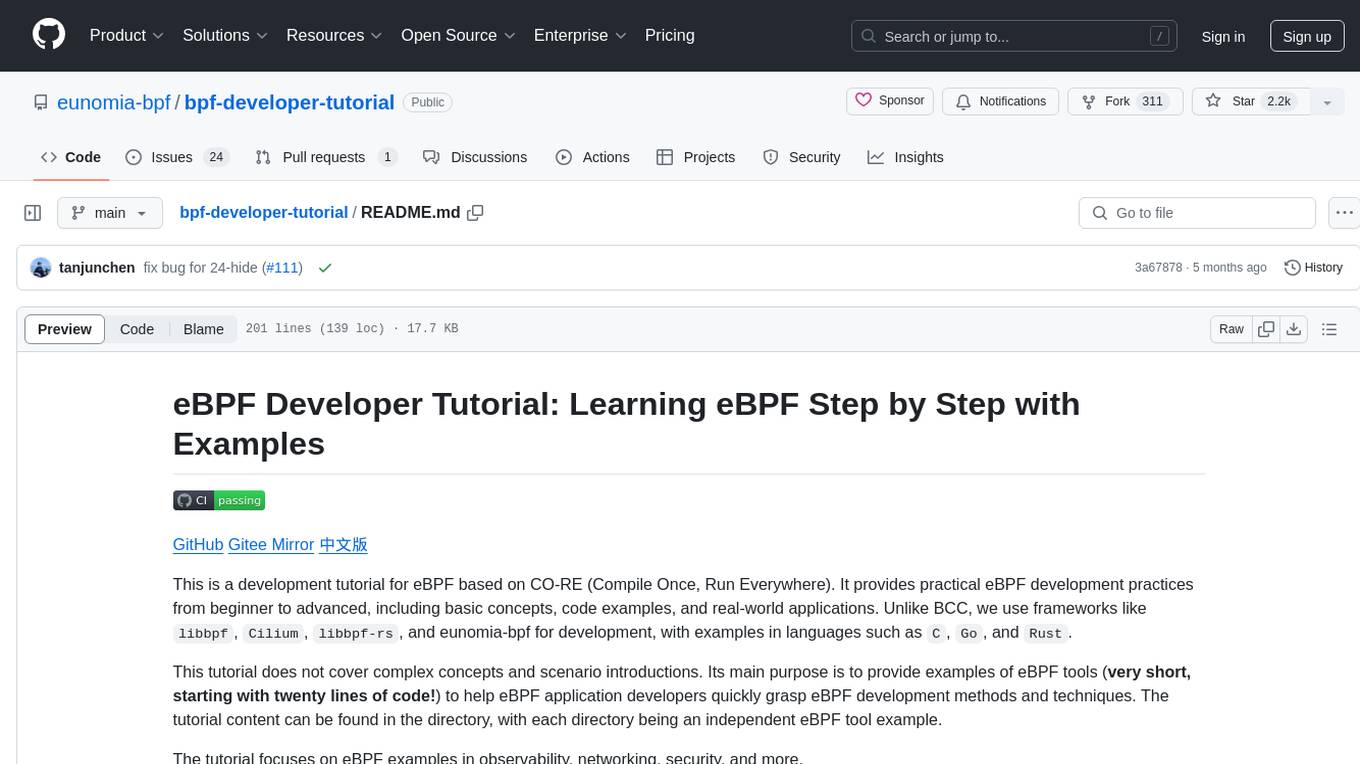
bpf-developer-tutorial
This is a development tutorial for eBPF based on CO-RE (Compile Once, Run Everywhere). It provides practical eBPF development practices from beginner to advanced, including basic concepts, code examples, and real-world applications. The tutorial focuses on eBPF examples in observability, networking, security, and more. It aims to help eBPF application developers quickly grasp eBPF development methods and techniques through examples in languages such as C, Go, and Rust. The tutorial is structured with independent eBPF tool examples in each directory, covering topics like kprobes, fentry, opensnoop, uprobe, sigsnoop, execsnoop, exitsnoop, runqlat, hardirqs, and more. The project is based on libbpf and frameworks like libbpf, Cilium, libbpf-rs, and eunomia-bpf for development.
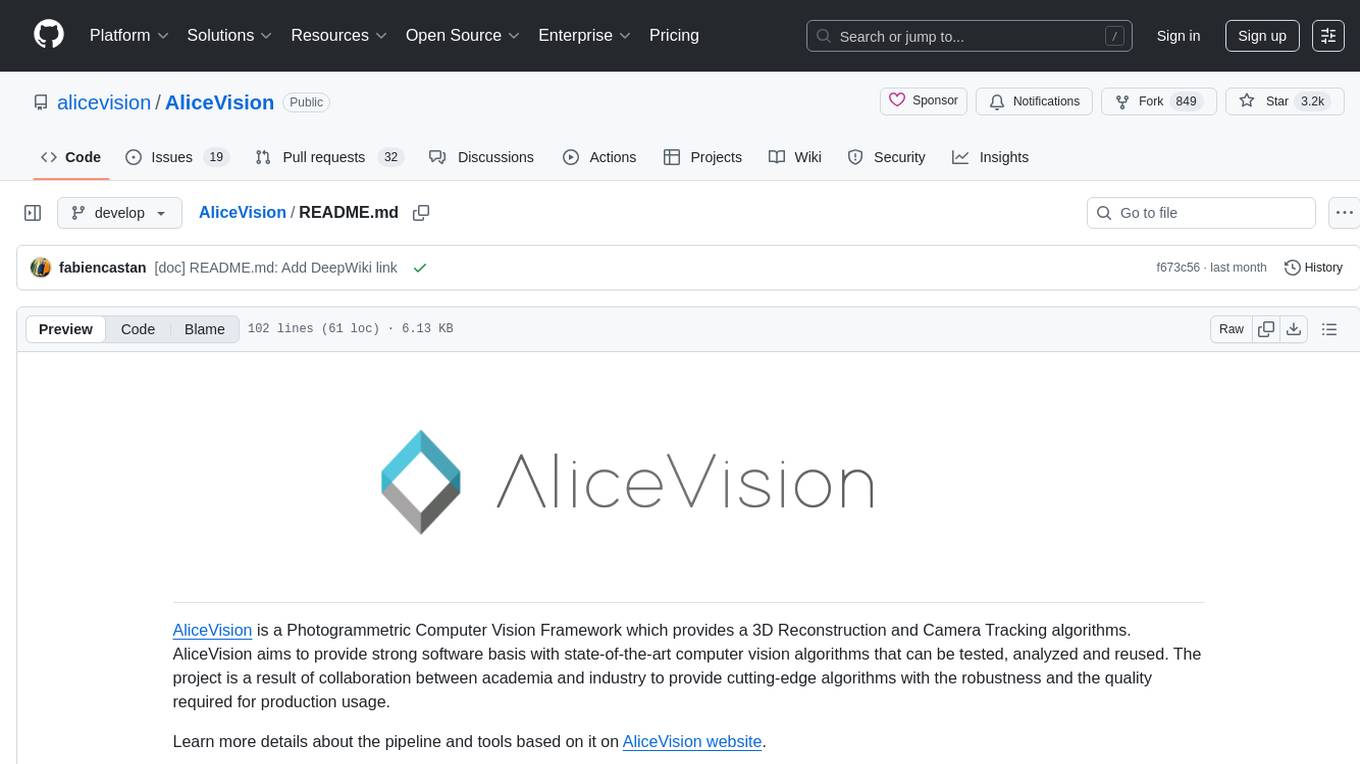
AliceVision
AliceVision is a photogrammetric computer vision framework which provides a 3D reconstruction pipeline. It is designed to process images from different viewpoints and create detailed 3D models of objects or scenes. The framework includes various algorithms for feature detection, matching, and structure from motion. AliceVision is suitable for researchers, developers, and enthusiasts interested in computer vision, photogrammetry, and 3D modeling. It can be used for applications such as creating 3D models of buildings, archaeological sites, or objects for virtual reality and augmented reality experiences.
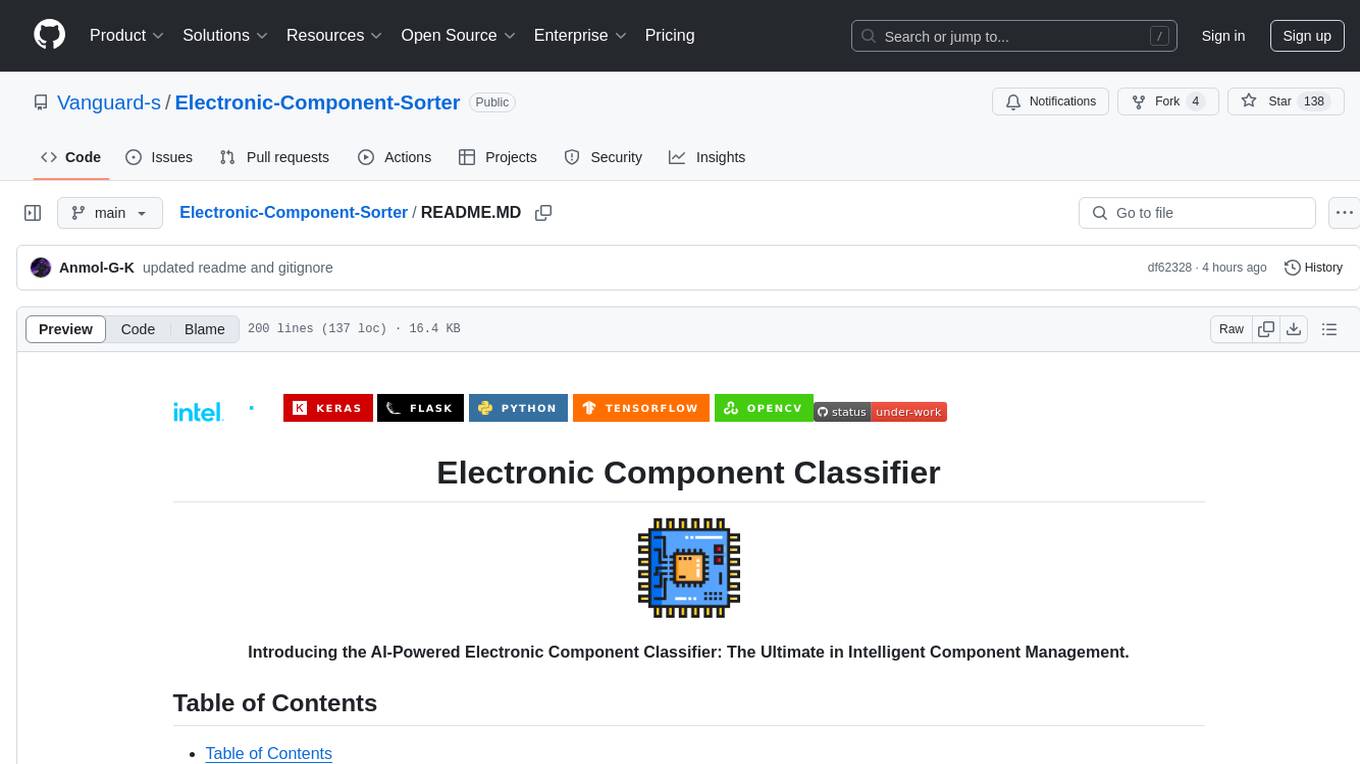
Electronic-Component-Sorter
The Electronic Component Classifier is a project that uses machine learning and artificial intelligence to automate the identification and classification of electrical and electronic components. It features component classification into seven classes, user-friendly design, and integration with Flask for a user-friendly interface. The project aims to reduce human error in component identification, make the process safer and more reliable, and potentially help visually impaired individuals in identifying electronic components.
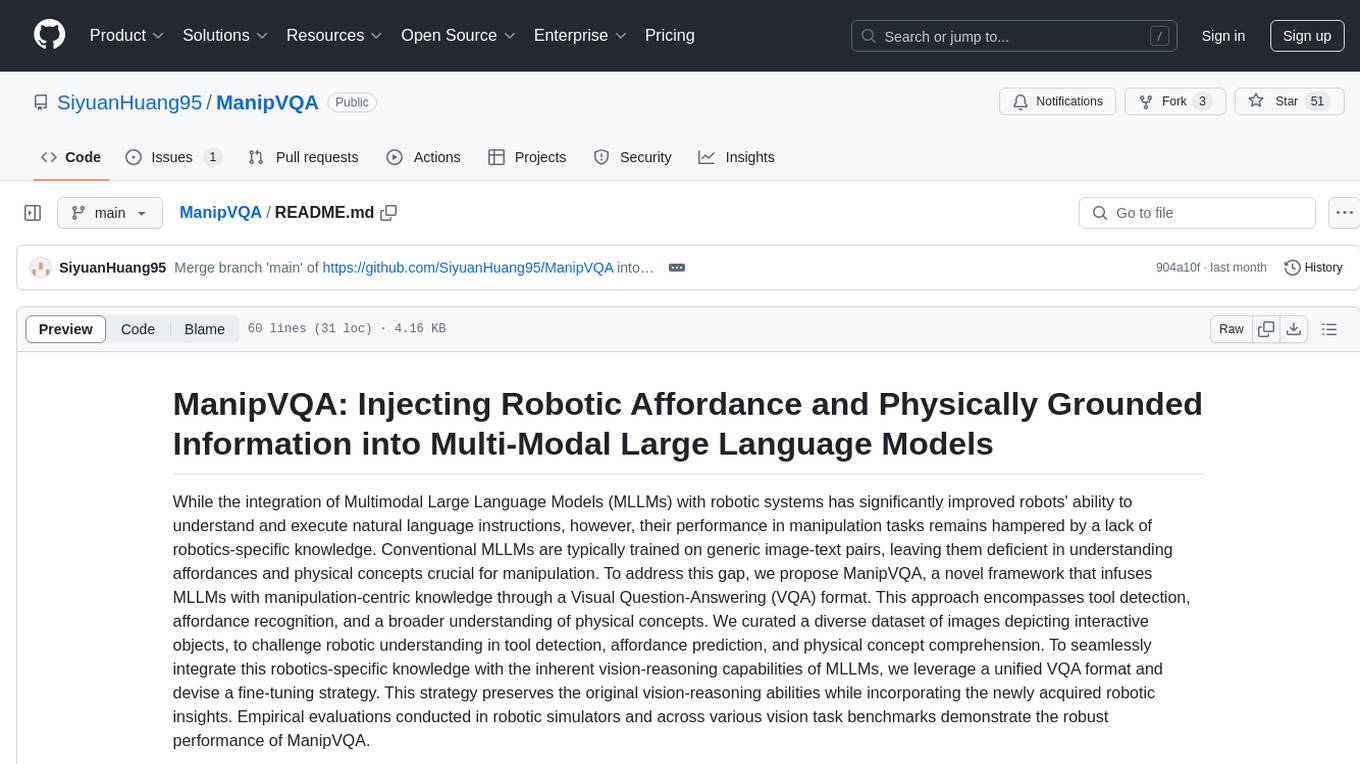
ManipVQA
ManipVQA is a framework that enhances Multimodal Large Language Models (MLLMs) with manipulation-centric knowledge through a Visual Question-Answering (VQA) format. It addresses the deficiency of conventional MLLMs in understanding affordances and physical concepts crucial for manipulation tasks. By infusing robotics-specific knowledge, including tool detection, affordance recognition, and physical concept comprehension, ManipVQA improves the performance of robots in manipulation tasks. The framework involves fine-tuning MLLMs with a curated dataset of interactive objects, enabling robots to understand and execute natural language instructions more effectively.
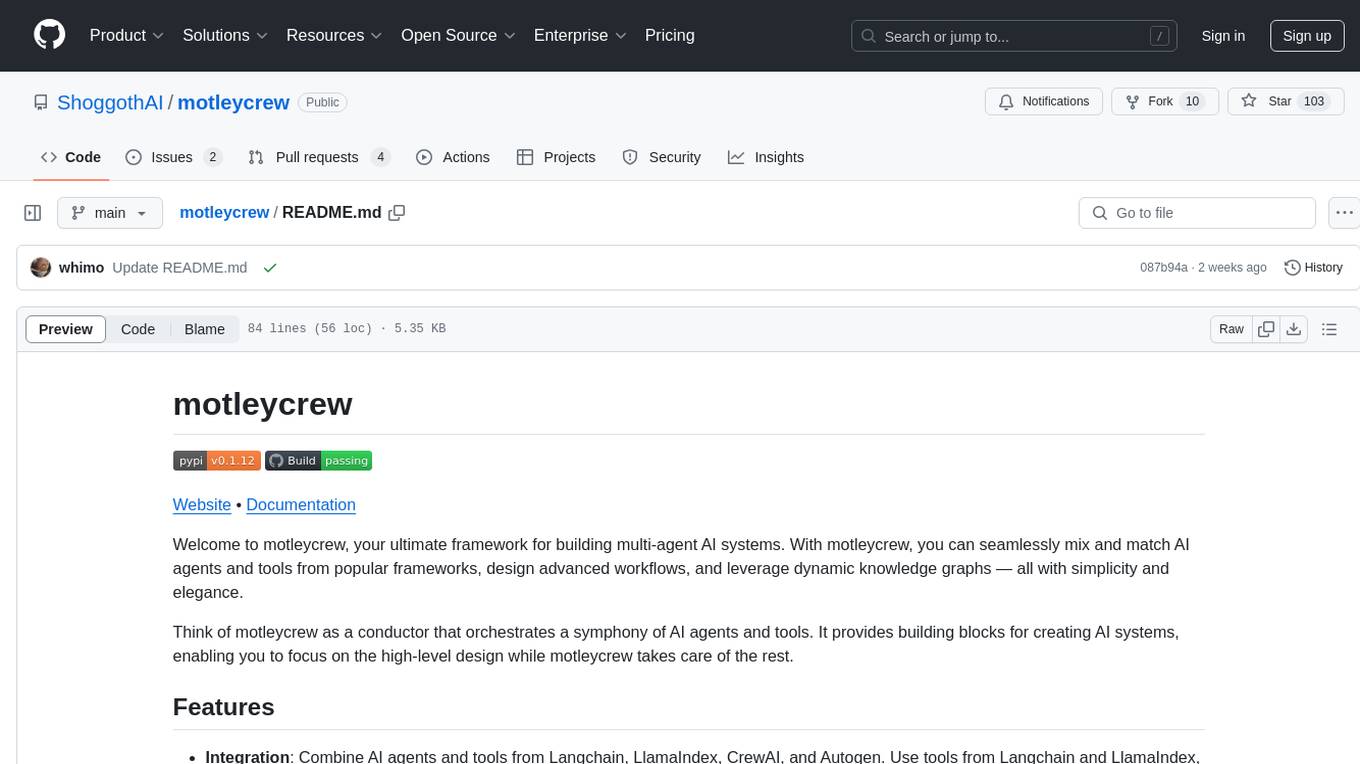
motleycrew
Motleycrew is an ultimate framework for building multi-agent AI systems, allowing users to mix and match AI agents and tools from popular frameworks, design advanced workflows, and leverage dynamic knowledge graphs with simplicity and elegance. It acts as a conductor orchestrating a symphony of AI agents and tools, providing building blocks for creating AI systems and enabling users to focus on high-level design while taking care of the rest. The framework offers integration with various tools, flexibility in providing agents with tools or other agents, advanced flow design capabilities, and built-in observability and caching features.
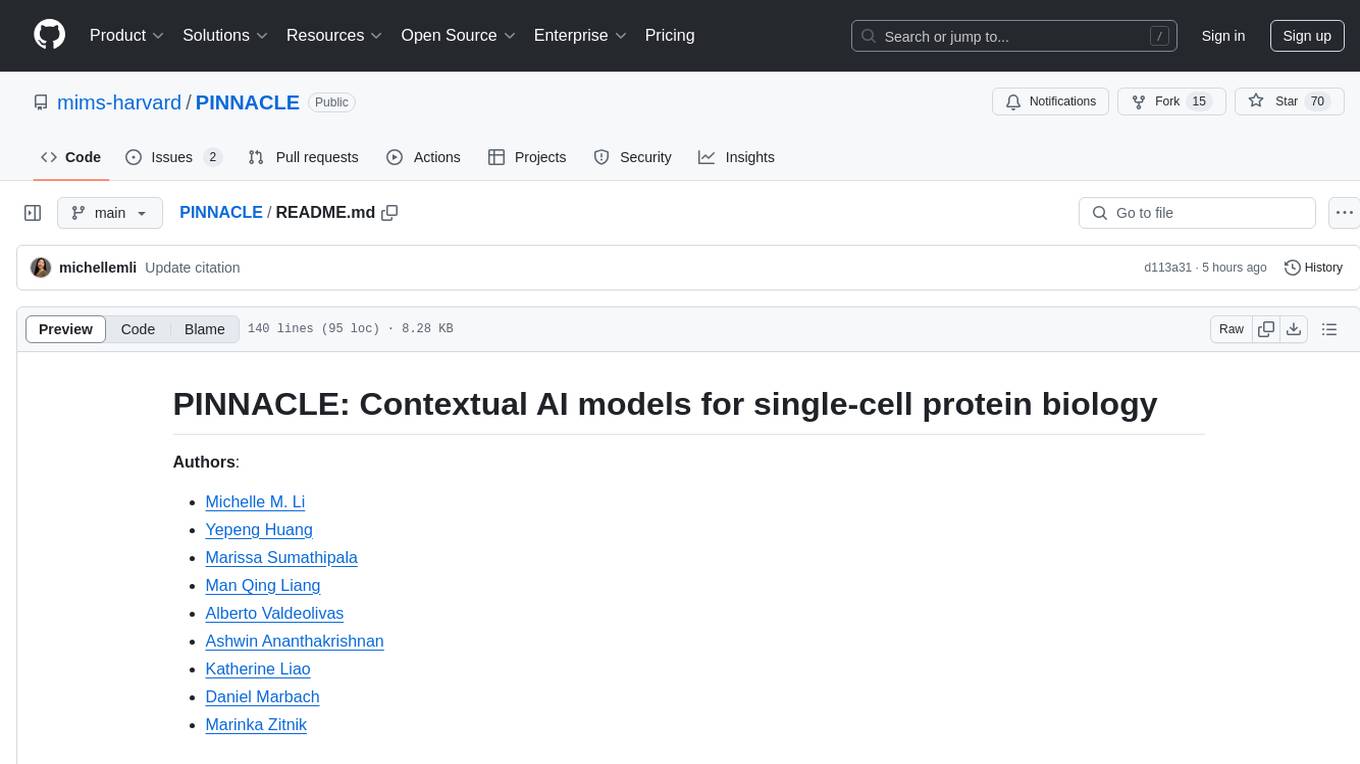
PINNACLE
PINNACLE is a flexible geometric deep learning approach that trains on contextualized protein interaction networks to generate context-aware protein representations. It provides protein representations split across various cell-type contexts from different tissues and organs. The tool can be fine-tuned to study the genomic effects of drugs and nominate promising protein targets and cell-type contexts for further investigation. PINNACLE exemplifies the paradigm of incorporating context-specific effects for studying biological systems, especially the impact of disease and therapeutics.
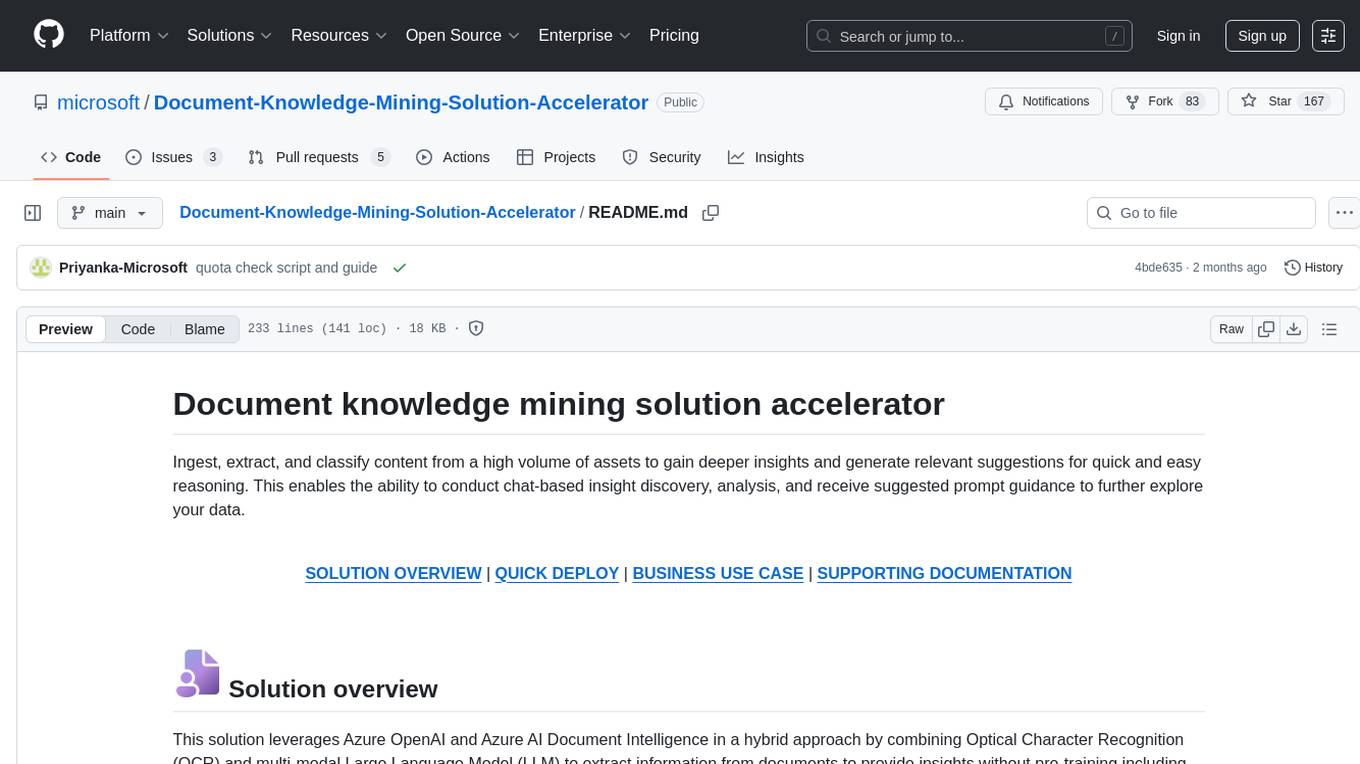
Document-Knowledge-Mining-Solution-Accelerator
The Document Knowledge Mining Solution Accelerator leverages Azure OpenAI and Azure AI Document Intelligence to ingest, extract, and classify content from various assets, enabling chat-based insight discovery, analysis, and prompt guidance. It uses OCR and multi-modal LLM to extract information from documents like text, handwritten text, charts, graphs, tables, and form fields. Users can customize the technical architecture and data processing workflow. Key features include ingesting and extracting real-world entities, chat-based insights discovery, text and document data analysis, prompt suggestion guidance, and multi-modal information processing.
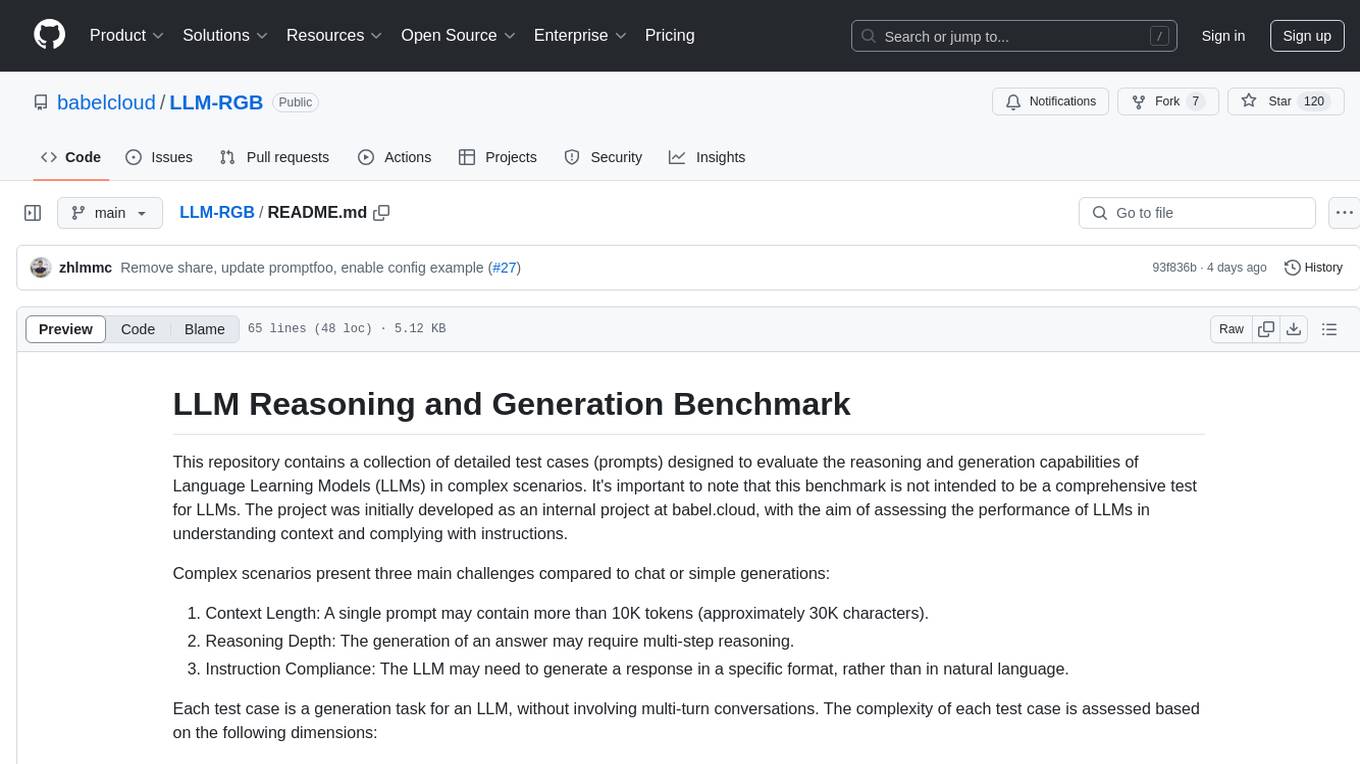
LLM-RGB
LLM-RGB is a repository containing a collection of detailed test cases designed to evaluate the reasoning and generation capabilities of Language Learning Models (LLMs) in complex scenarios. The benchmark assesses LLMs' performance in understanding context, complying with instructions, and handling challenges like long context lengths, multi-step reasoning, and specific response formats. Each test case evaluates an LLM's output based on context length difficulty, reasoning depth difficulty, and instruction compliance difficulty, with a final score calculated for each test case. The repository provides a score table, evaluation details, and quick start guide for running evaluations using promptfoo testing tools.
For similar tasks
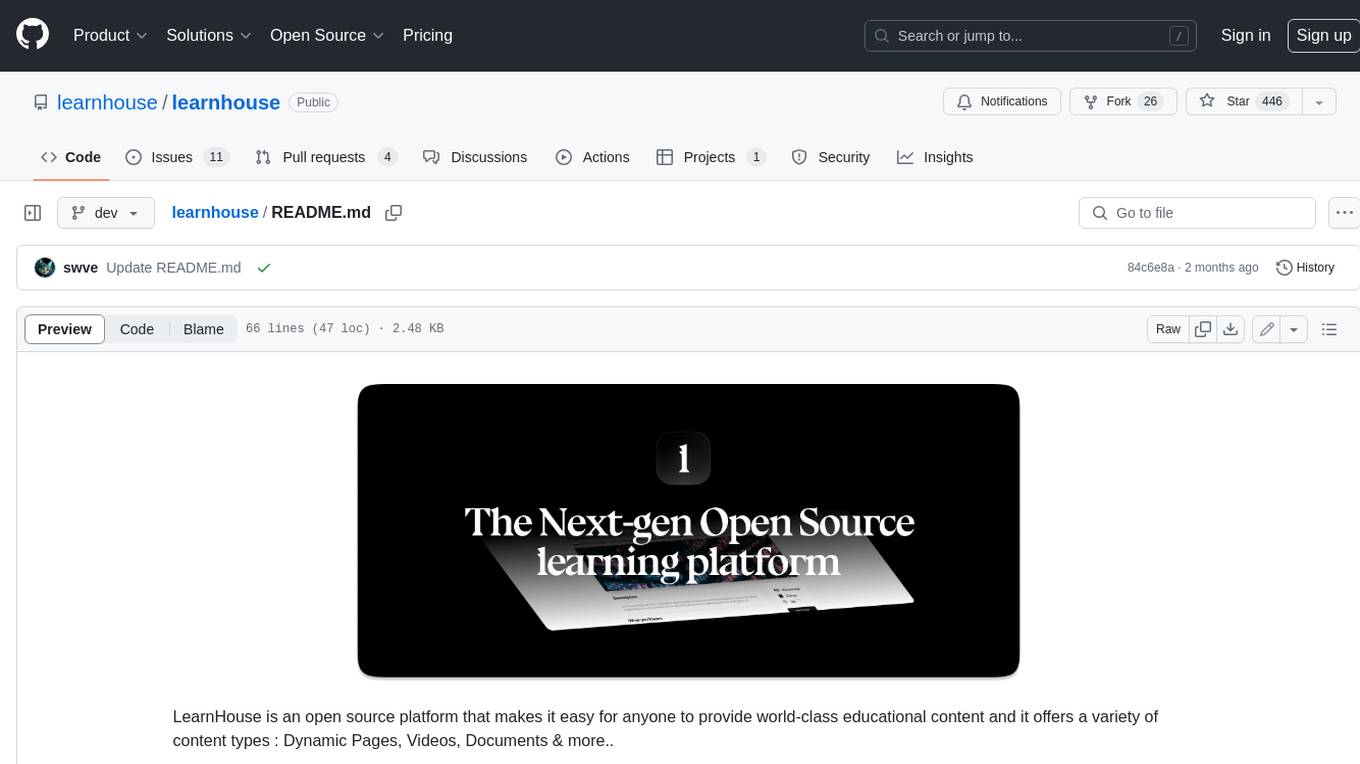
learnhouse
LearnHouse is an open-source platform that allows anyone to easily provide world-class educational content. It supports various content types, including dynamic pages, videos, and documents. The platform is still in early development and should not be used in production environments. However, it offers several features, such as dynamic Notion-like pages, ease of use, multi-organization support, support for uploading videos and documents, course collections, user management, quizzes, course progress tracking, and an AI-powered assistant for teachers and students. LearnHouse is built using various open-source projects, including Next.js, TailwindCSS, Radix UI, Tiptap, FastAPI, YJS, PostgreSQL, LangChain, and React.

PromptChains
ChatGPT Queue Prompts is a collection of prompt chains designed to enhance interactions with large language models like ChatGPT. These prompt chains help build context for the AI before performing specific tasks, improving performance. Users can copy and paste prompt chains into the ChatGPT Queue extension to process prompts in sequence. The repository includes example prompt chains for tasks like conducting AI company research, building SEO optimized blog posts, creating courses, revising resumes, enriching leads for CRM, personal finance document creation, workout and nutrition plans, marketing plans, and more.
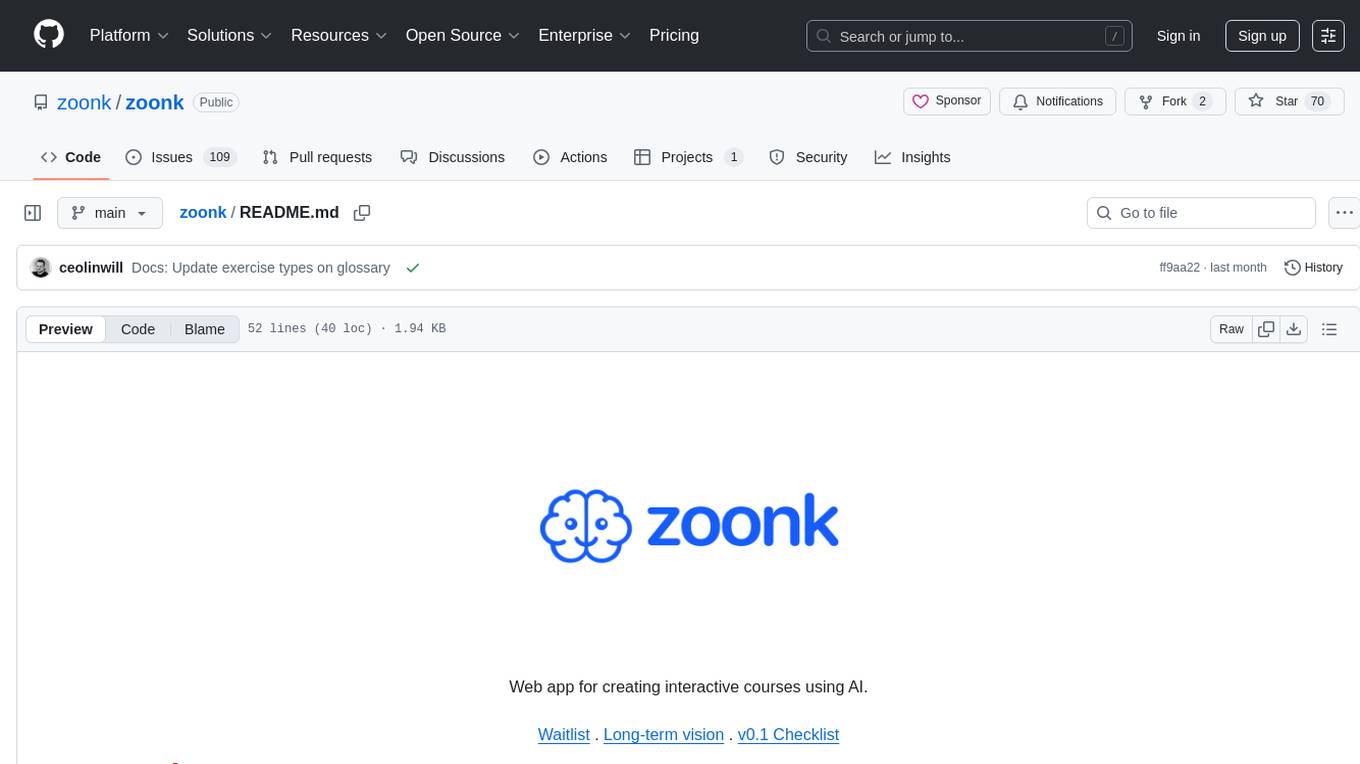
zoonk
Zoonk is a web app designed for creating interactive courses using AI. Currently in early development stage, it is not yet ready for use but aims to be available for testing and contributions in the future. The project focuses on leveraging AI technology to enhance the learning experience by providing interactive course creation tools. Zoonk also conducts model evaluations on different prompts to improve its AI capabilities. The project has garnered support from various individuals who believe in its vision and potential.

crewAI
CrewAI is a cutting-edge framework designed to orchestrate role-playing autonomous AI agents. By fostering collaborative intelligence, CrewAI empowers agents to work together seamlessly, tackling complex tasks. It enables AI agents to assume roles, share goals, and operate in a cohesive unit, much like a well-oiled crew. Whether you're building a smart assistant platform, an automated customer service ensemble, or a multi-agent research team, CrewAI provides the backbone for sophisticated multi-agent interactions. With features like role-based agent design, autonomous inter-agent delegation, flexible task management, and support for various LLMs, CrewAI offers a dynamic and adaptable solution for both development and production workflows.
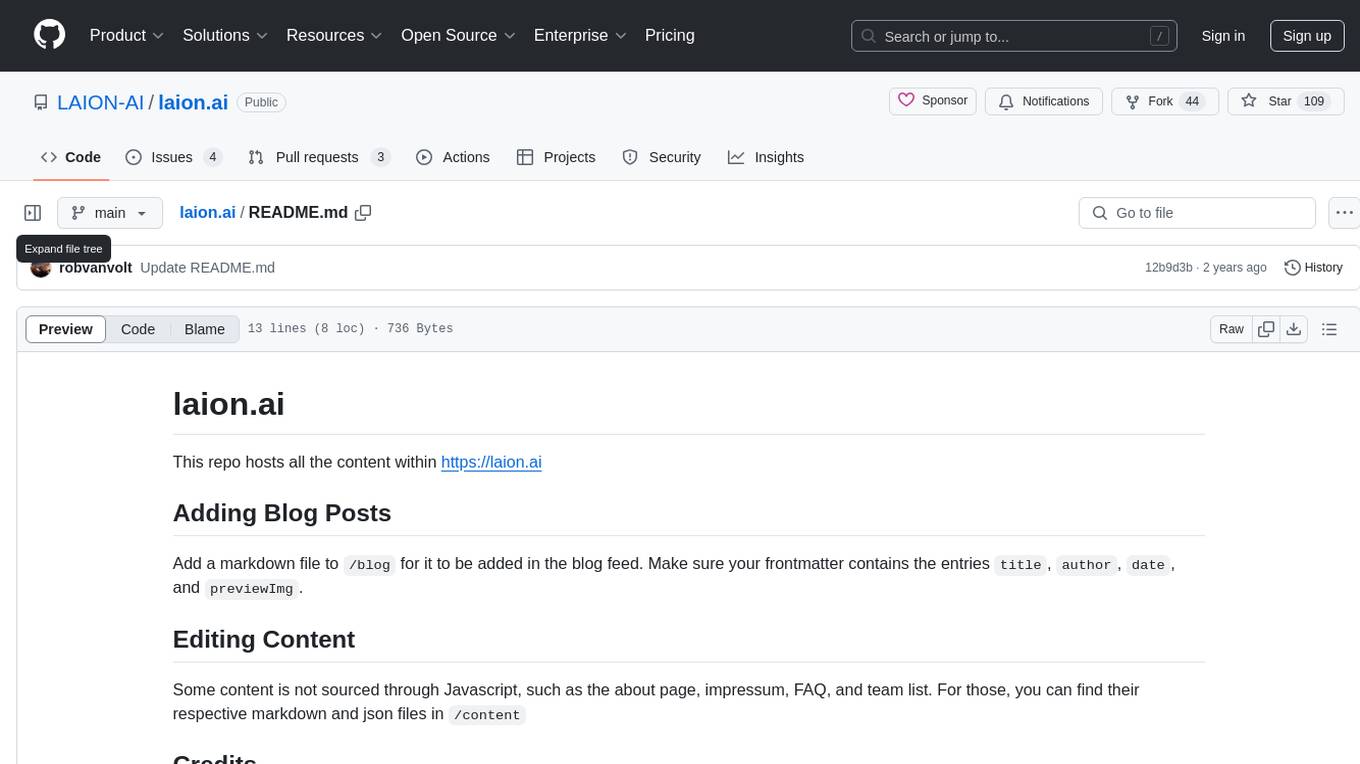
laion.ai
laion.ai is a repository hosting content for the website https://laion.ai. It includes blog posts, markdown files for content editing, and credits to contributors. The content covers various topics such as about page, impressum, FAQ, team list, and blog feed.
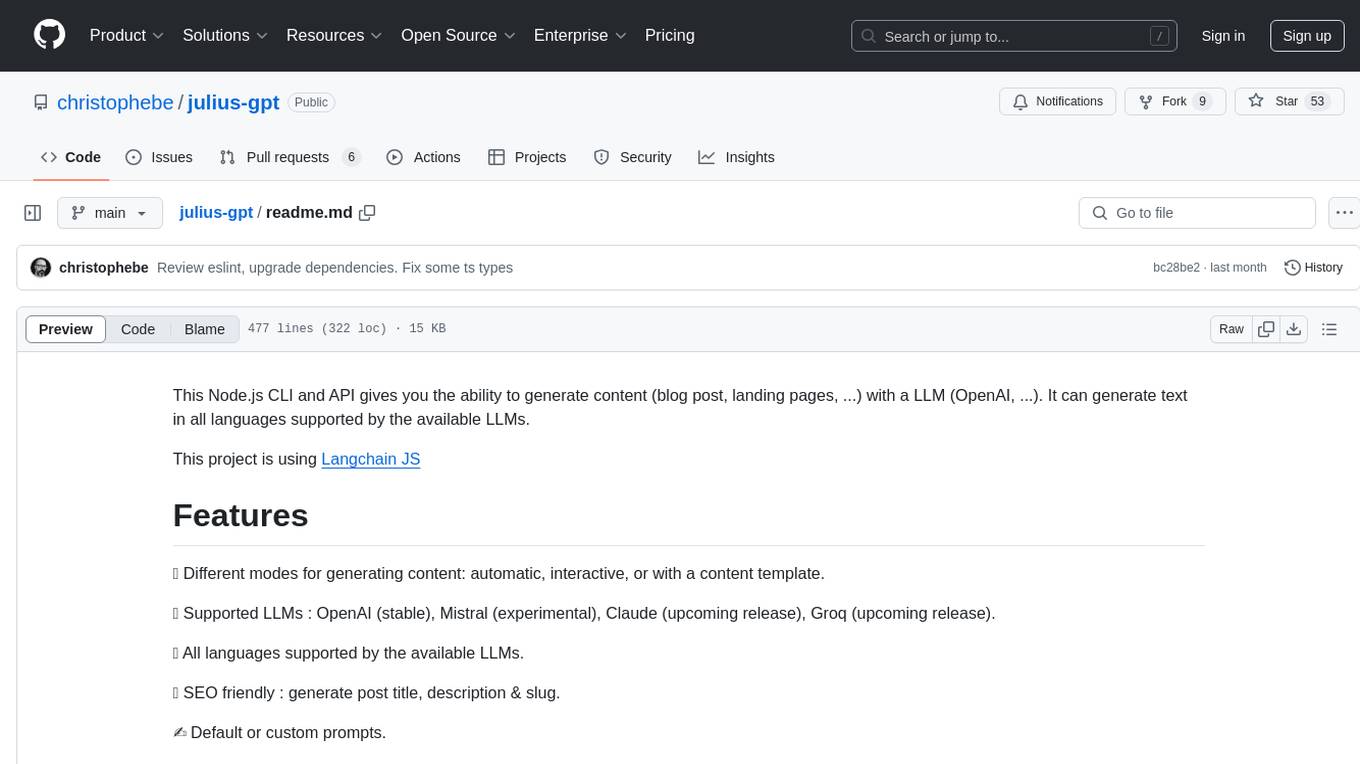
julius-gpt
julius-gpt is a Node.js CLI and API tool that enables users to generate content such as blog posts and landing pages using Large Language Models (LLMs) like OpenAI. It supports generating text in multiple languages provided by the available LLMs. The tool offers different modes for content generation, including automatic, interactive, or using a content template. Users can fine-tune the content generation process with completion parameters and create SEO-friendly content with post titles, descriptions, and slugs. Additionally, users can publish content on WordPress and access upcoming features like image generation and RAG. The tool also supports custom prompts for personalized content generation and offers various commands for WordPress-related tasks.
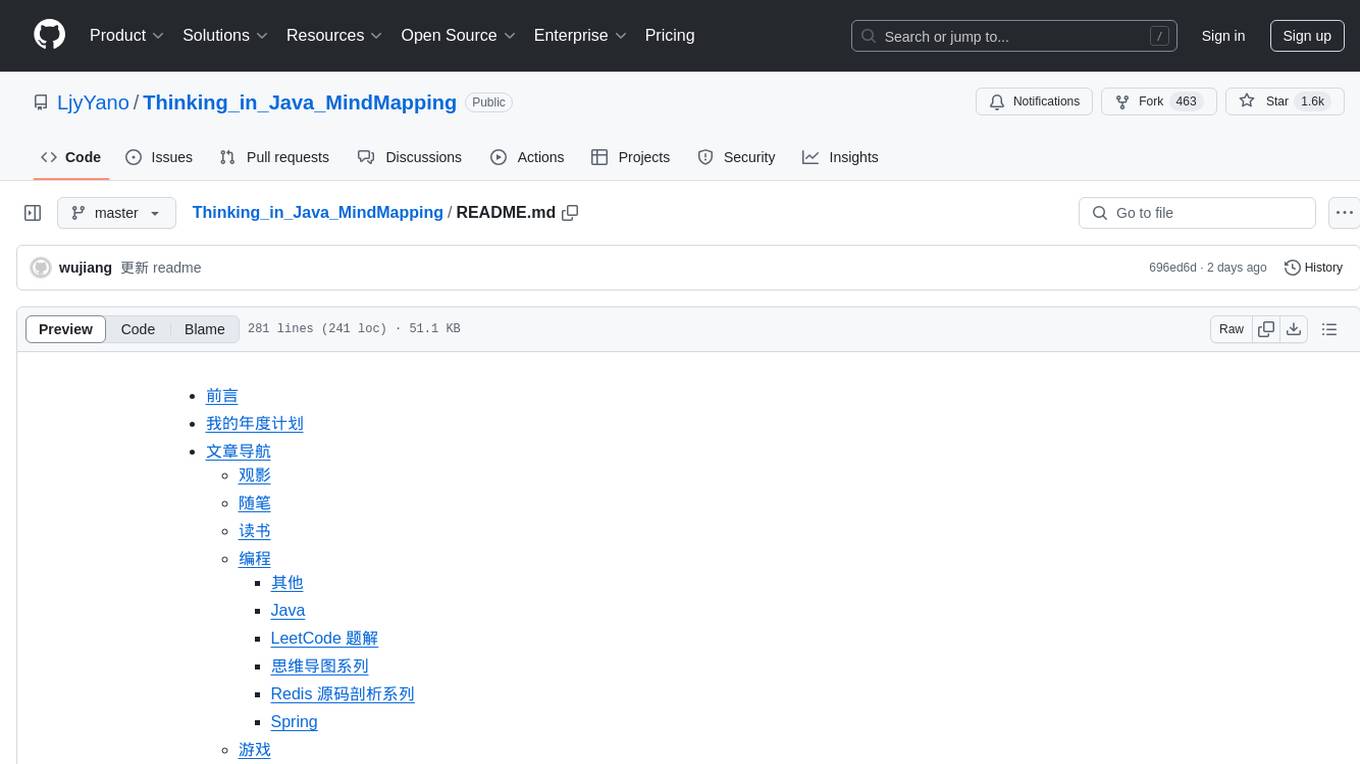
Thinking_in_Java_MindMapping
Thinking_in_Java_MindMapping is a repository that started as a project to create mind maps based on the book 'Java Programming Ideas'. Over time, it evolved into a collection of programming notes, blog posts, book summaries, personal reflections, and even gaming content. The repository covers a wide range of topics, allowing the author to freely express thoughts and ideas. The content is diverse and reflects the author's dedication to consistency and creativity.
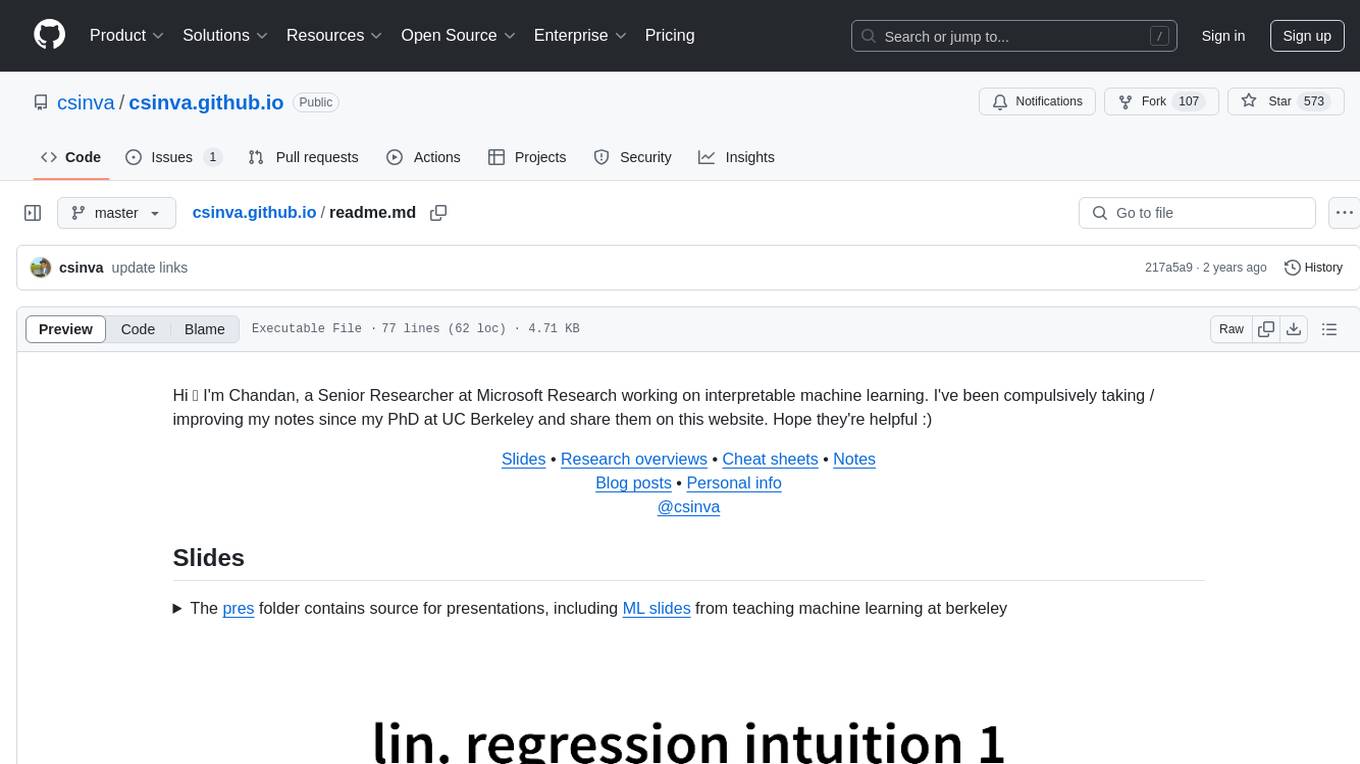
csinva.github.io
csinva.github.io is a repository maintained by Chandan, a Senior Researcher at Microsoft Research, focusing on interpretable machine learning. The repository contains slides, research overviews, cheat sheets, notes, blog posts, and personal information related to machine learning, statistics, and neuroscience. It offers resources for presentations, summaries of recent papers, cheat sheets for various courses, and posts on different aspects of machine learning and neuroscience advancements.
For similar jobs
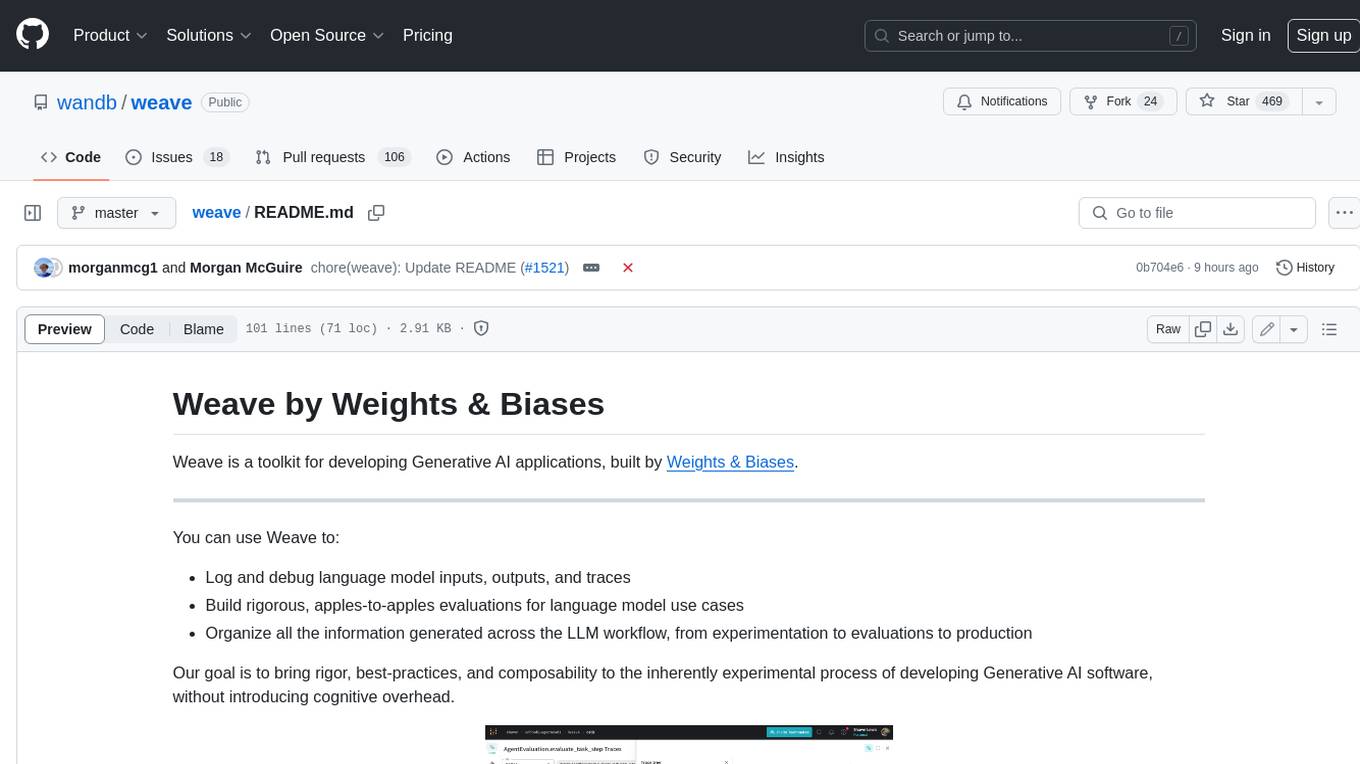
weave
Weave is a toolkit for developing Generative AI applications, built by Weights & Biases. With Weave, you can log and debug language model inputs, outputs, and traces; build rigorous, apples-to-apples evaluations for language model use cases; and organize all the information generated across the LLM workflow, from experimentation to evaluations to production. Weave aims to bring rigor, best-practices, and composability to the inherently experimental process of developing Generative AI software, without introducing cognitive overhead.

LLMStack
LLMStack is a no-code platform for building generative AI agents, workflows, and chatbots. It allows users to connect their own data, internal tools, and GPT-powered models without any coding experience. LLMStack can be deployed to the cloud or on-premise and can be accessed via HTTP API or triggered from Slack or Discord.

VisionCraft
The VisionCraft API is a free API for using over 100 different AI models. From images to sound.

kaito
Kaito is an operator that automates the AI/ML inference model deployment in a Kubernetes cluster. It manages large model files using container images, avoids tuning deployment parameters to fit GPU hardware by providing preset configurations, auto-provisions GPU nodes based on model requirements, and hosts large model images in the public Microsoft Container Registry (MCR) if the license allows. Using Kaito, the workflow of onboarding large AI inference models in Kubernetes is largely simplified.

PyRIT
PyRIT is an open access automation framework designed to empower security professionals and ML engineers to red team foundation models and their applications. It automates AI Red Teaming tasks to allow operators to focus on more complicated and time-consuming tasks and can also identify security harms such as misuse (e.g., malware generation, jailbreaking), and privacy harms (e.g., identity theft). The goal is to allow researchers to have a baseline of how well their model and entire inference pipeline is doing against different harm categories and to be able to compare that baseline to future iterations of their model. This allows them to have empirical data on how well their model is doing today, and detect any degradation of performance based on future improvements.

tabby
Tabby is a self-hosted AI coding assistant, offering an open-source and on-premises alternative to GitHub Copilot. It boasts several key features: * Self-contained, with no need for a DBMS or cloud service. * OpenAPI interface, easy to integrate with existing infrastructure (e.g Cloud IDE). * Supports consumer-grade GPUs.

spear
SPEAR (Simulator for Photorealistic Embodied AI Research) is a powerful tool for training embodied agents. It features 300 unique virtual indoor environments with 2,566 unique rooms and 17,234 unique objects that can be manipulated individually. Each environment is designed by a professional artist and features detailed geometry, photorealistic materials, and a unique floor plan and object layout. SPEAR is implemented as Unreal Engine assets and provides an OpenAI Gym interface for interacting with the environments via Python.

Magick
Magick is a groundbreaking visual AIDE (Artificial Intelligence Development Environment) for no-code data pipelines and multimodal agents. Magick can connect to other services and comes with nodes and templates well-suited for intelligent agents, chatbots, complex reasoning systems and realistic characters.